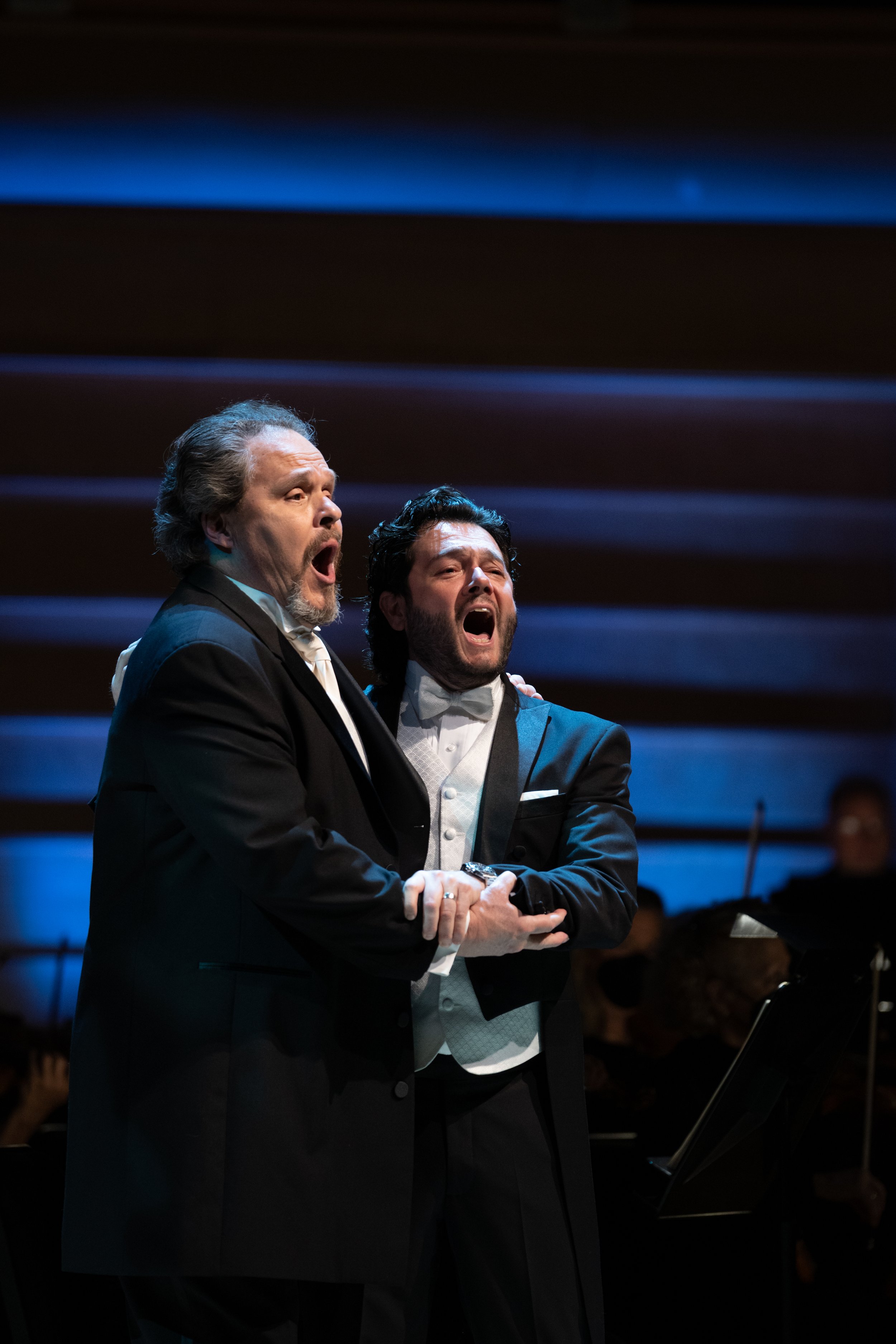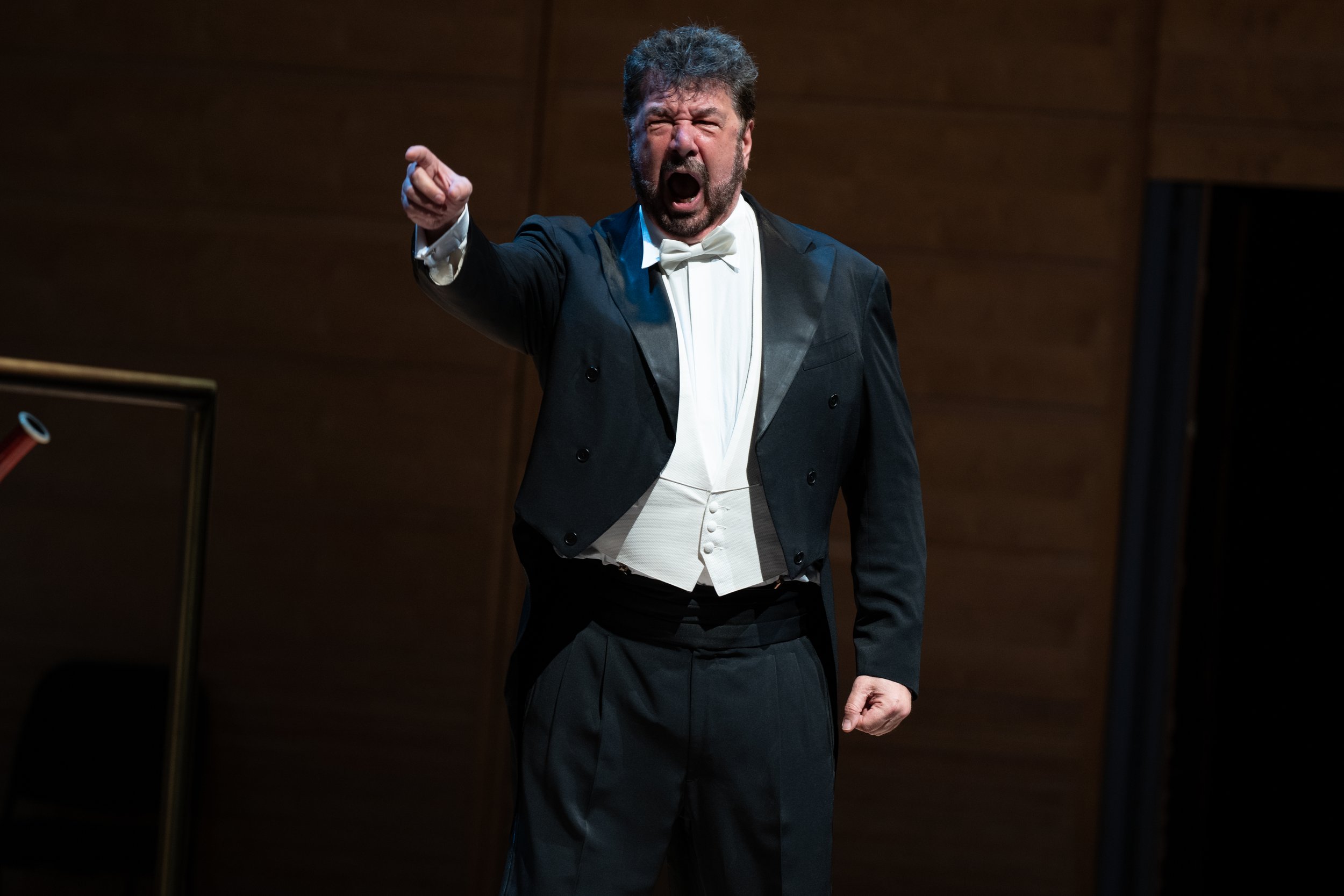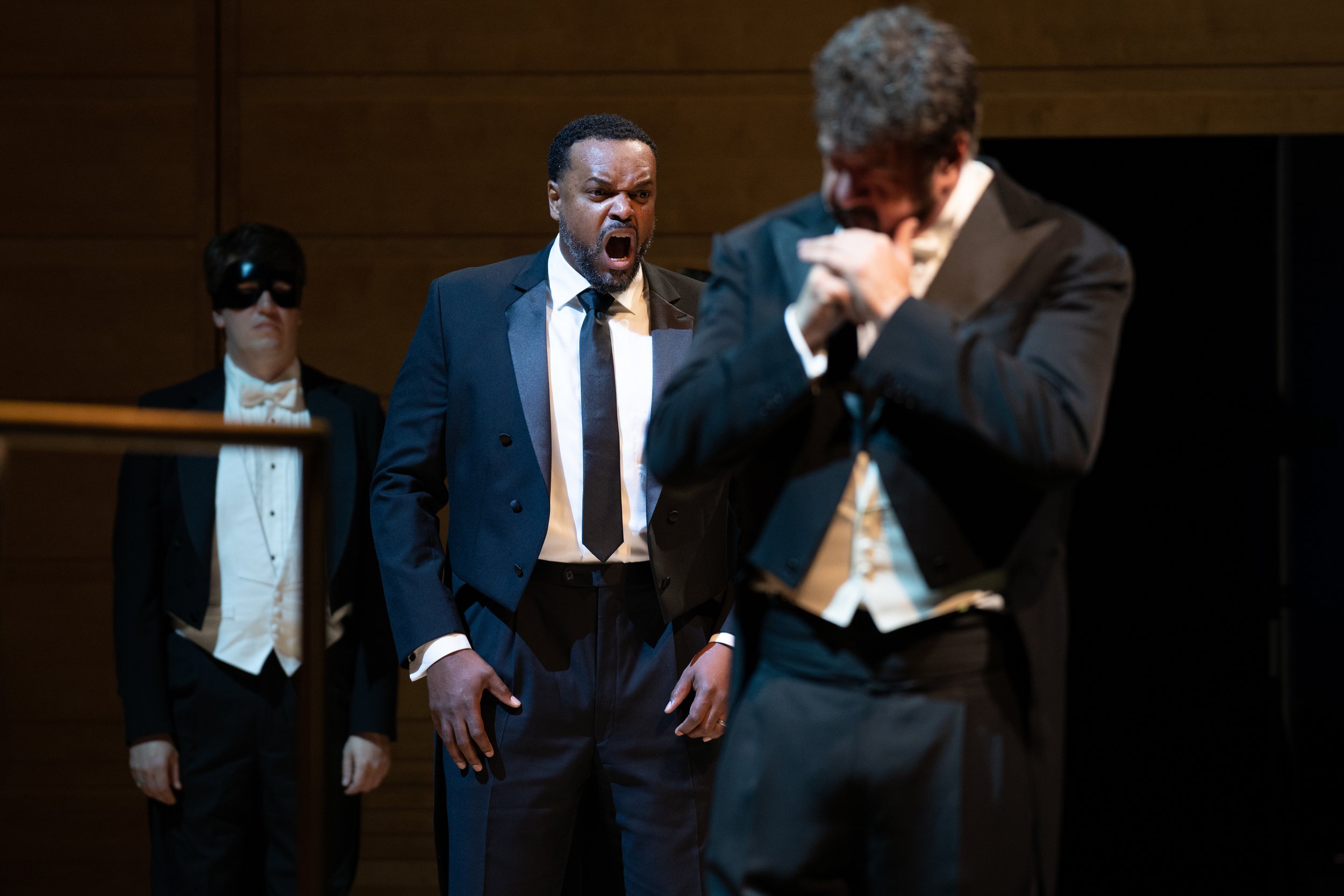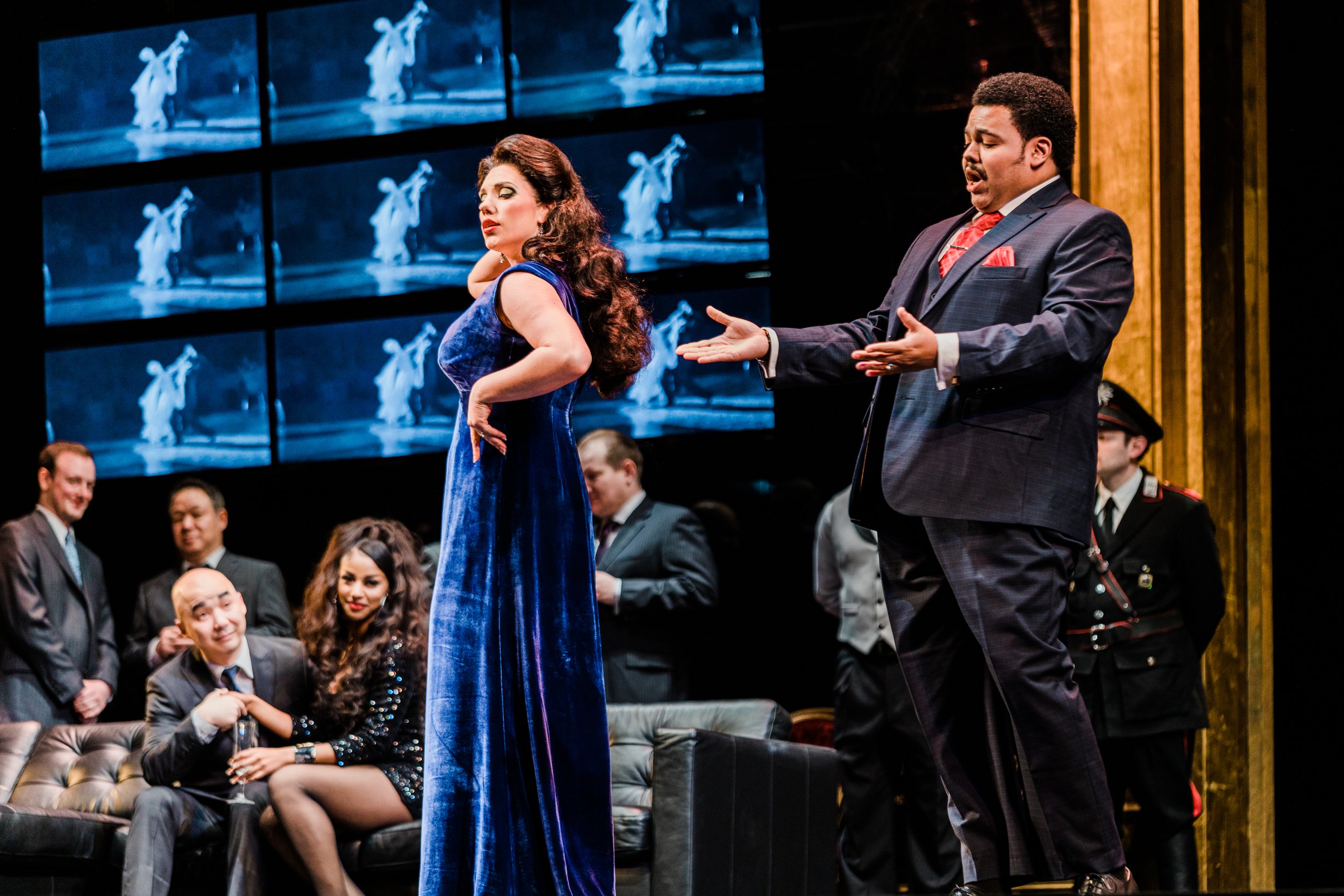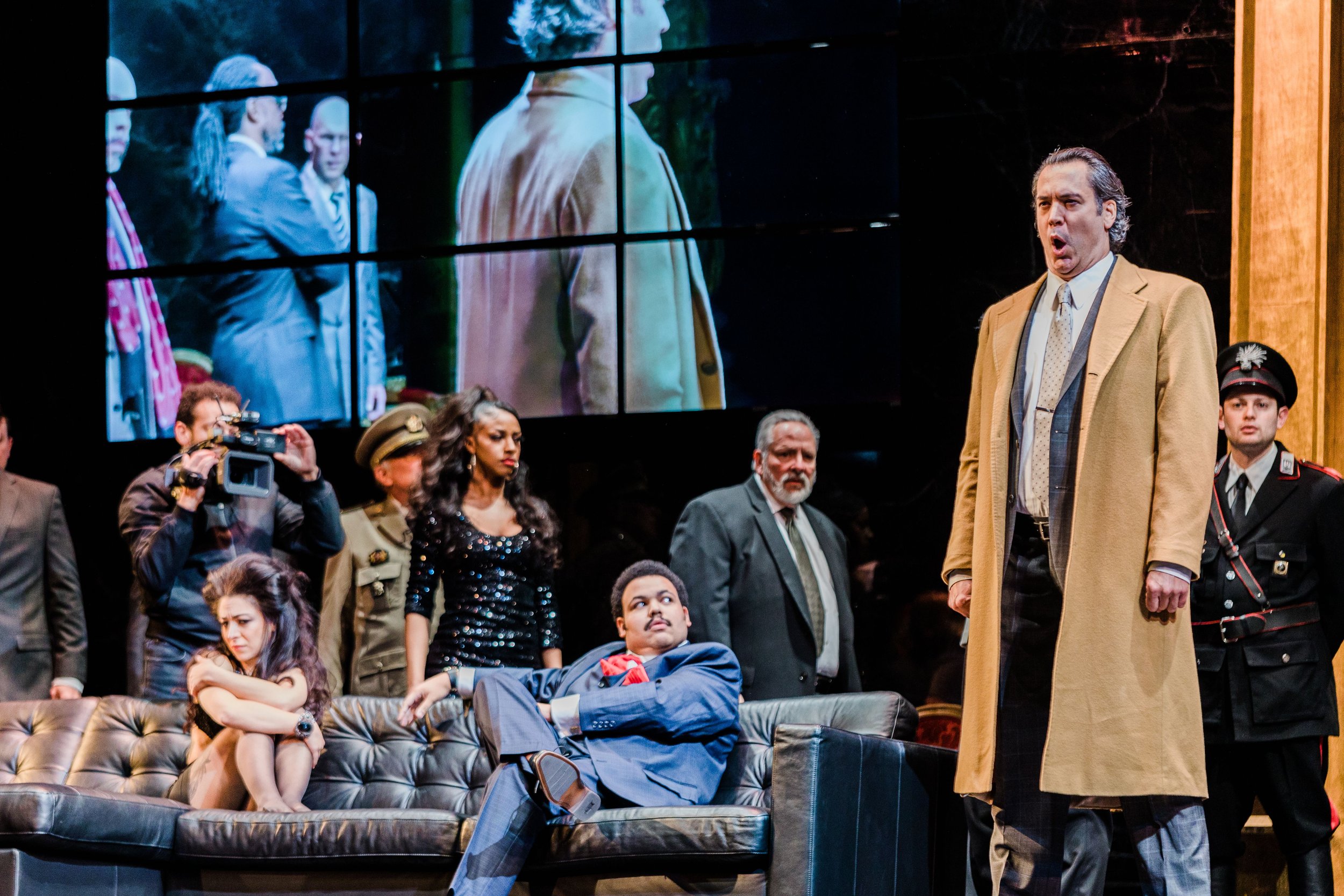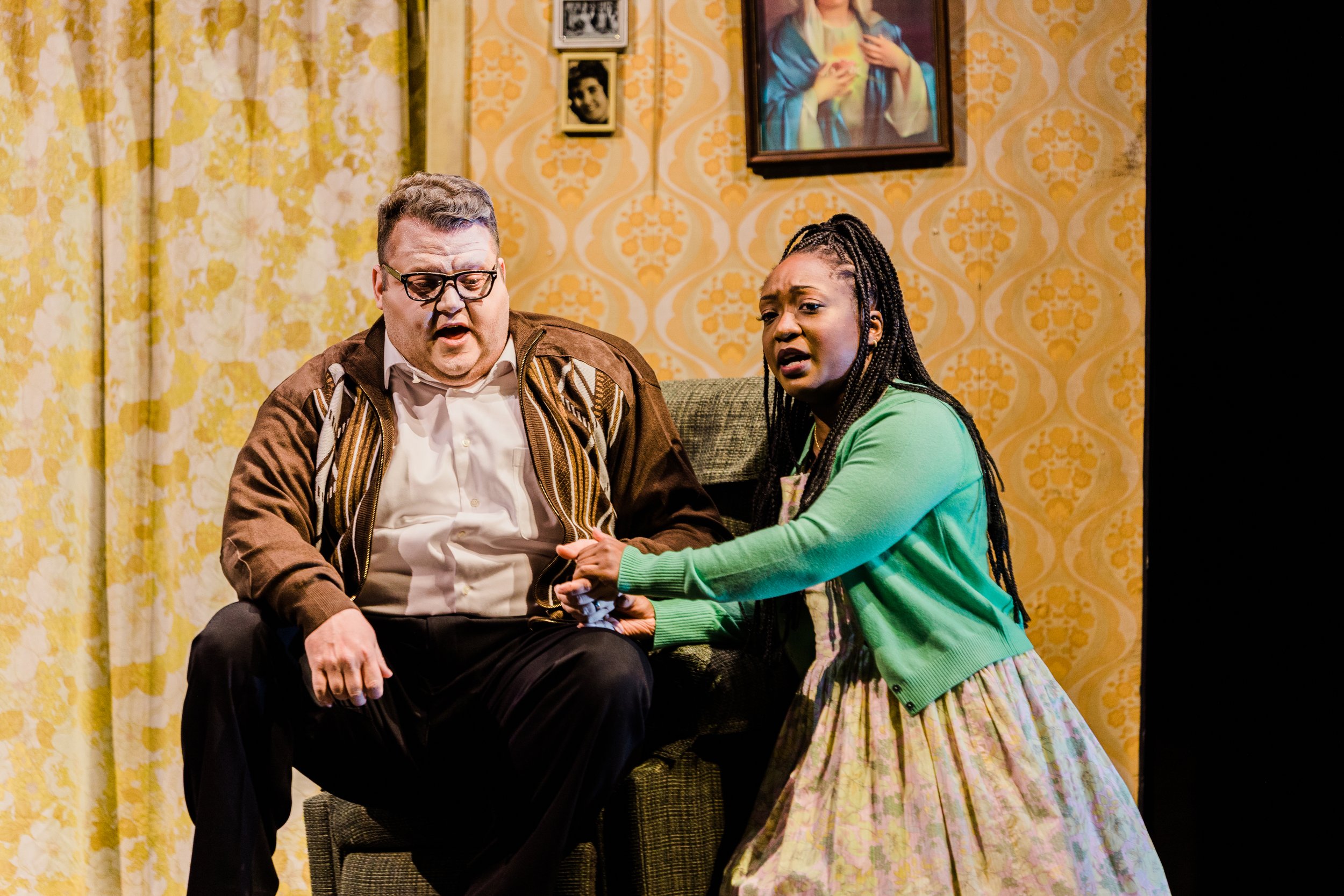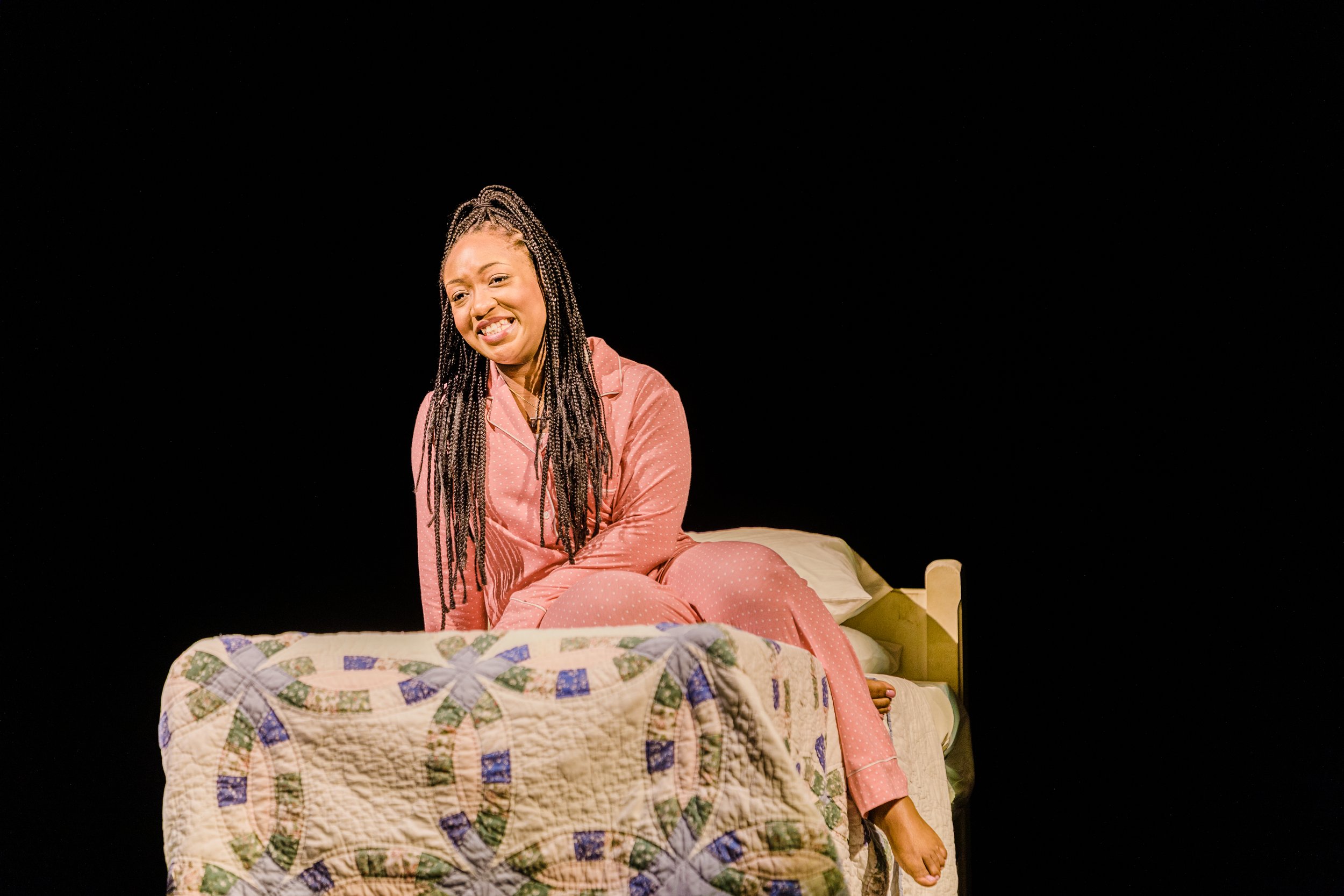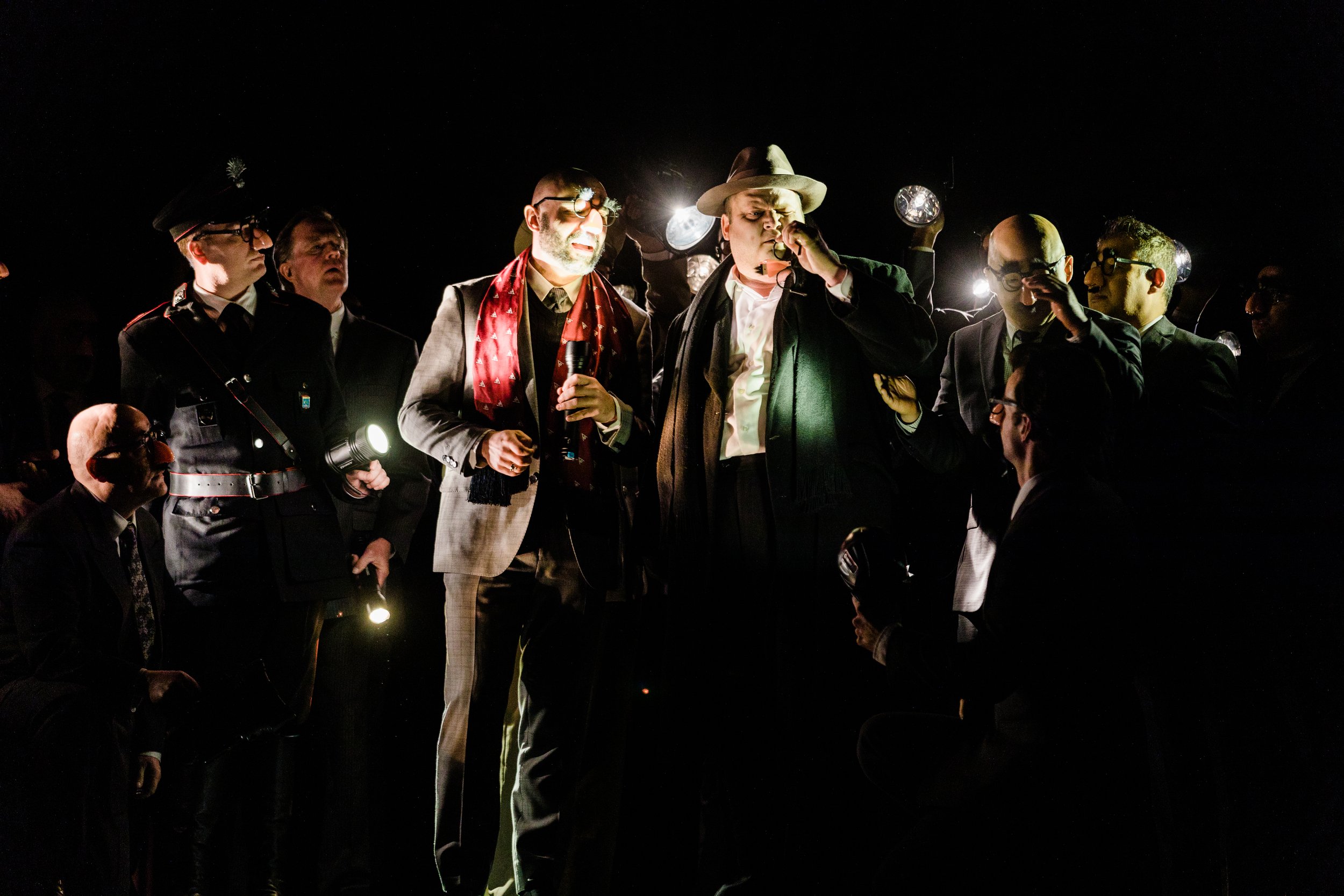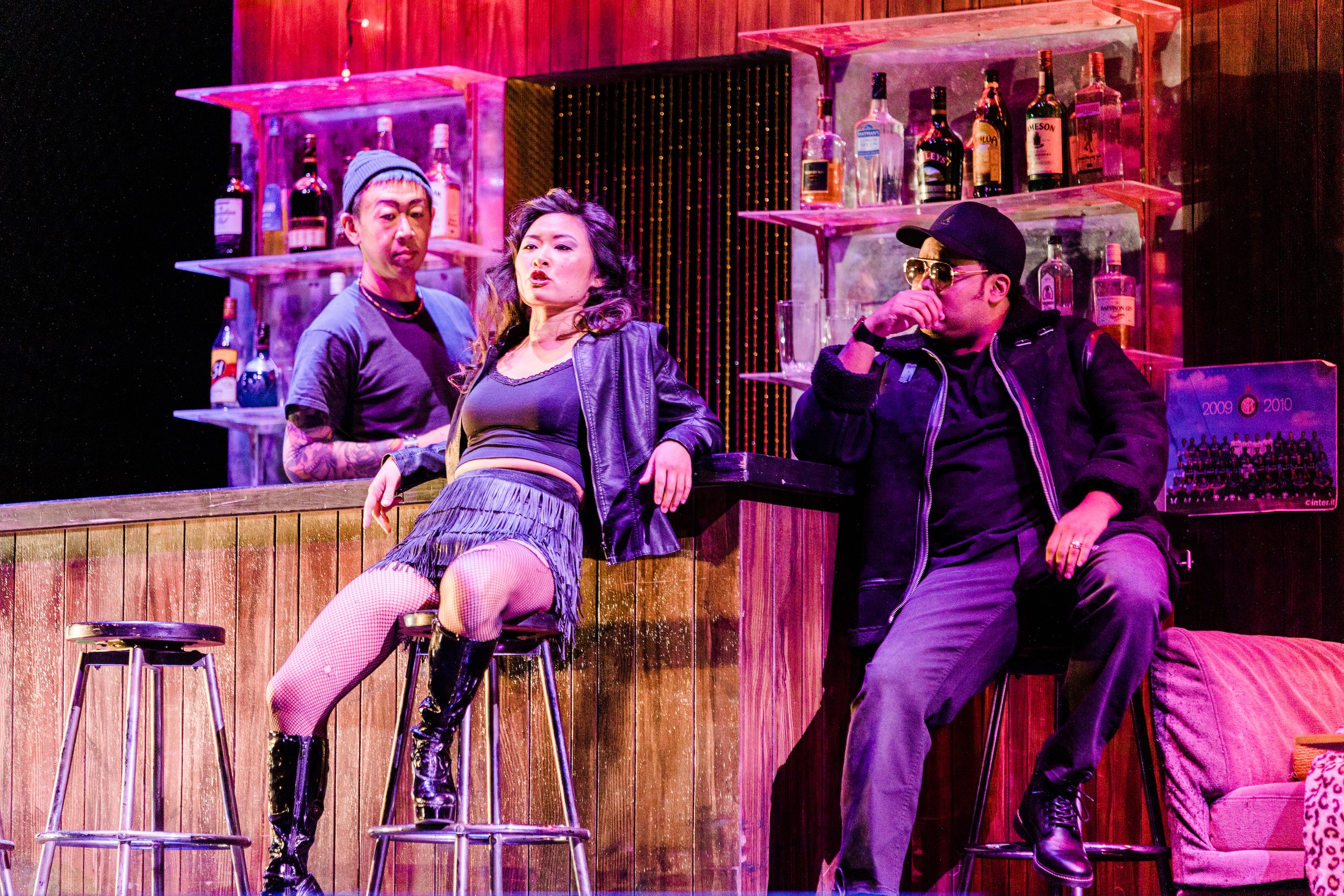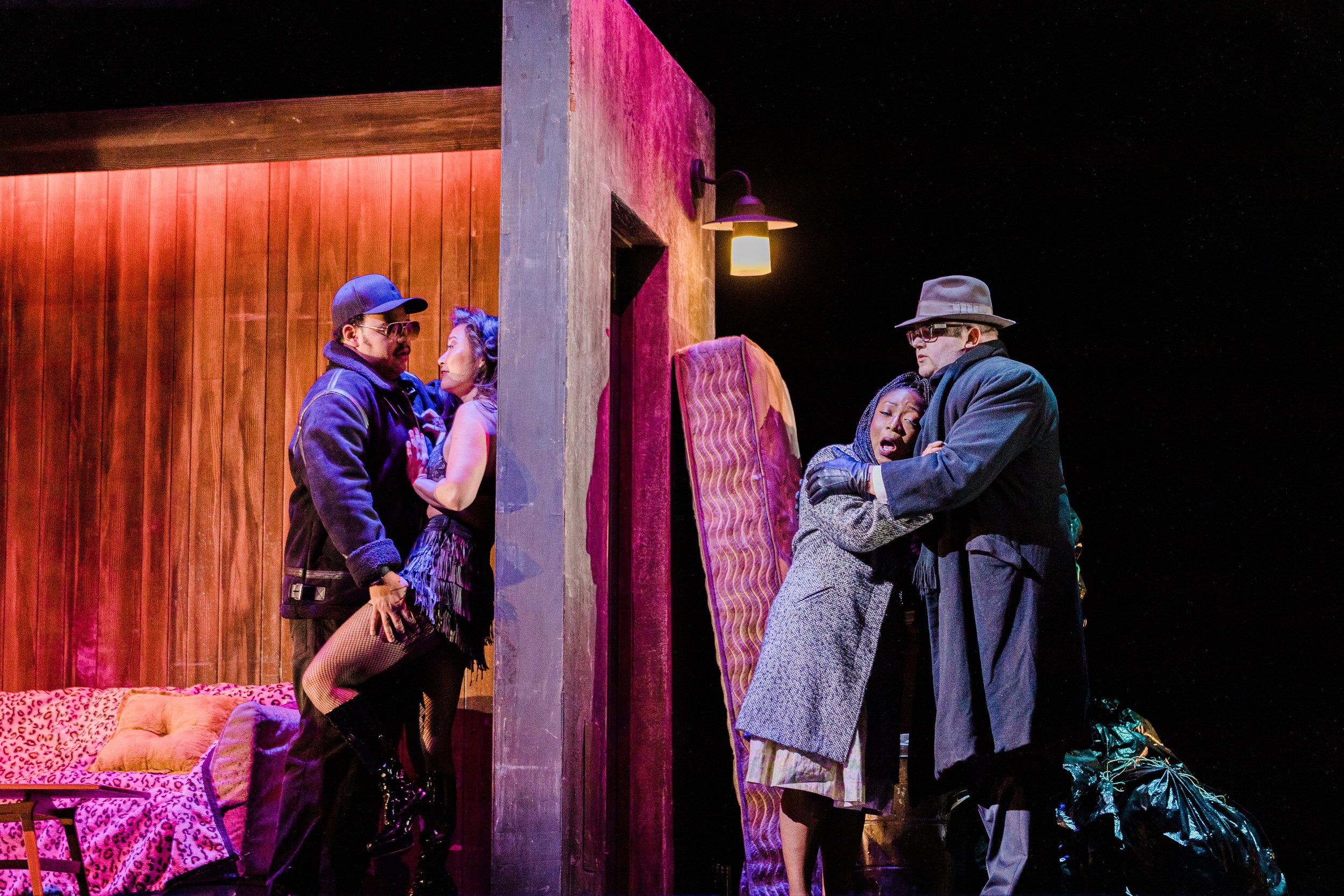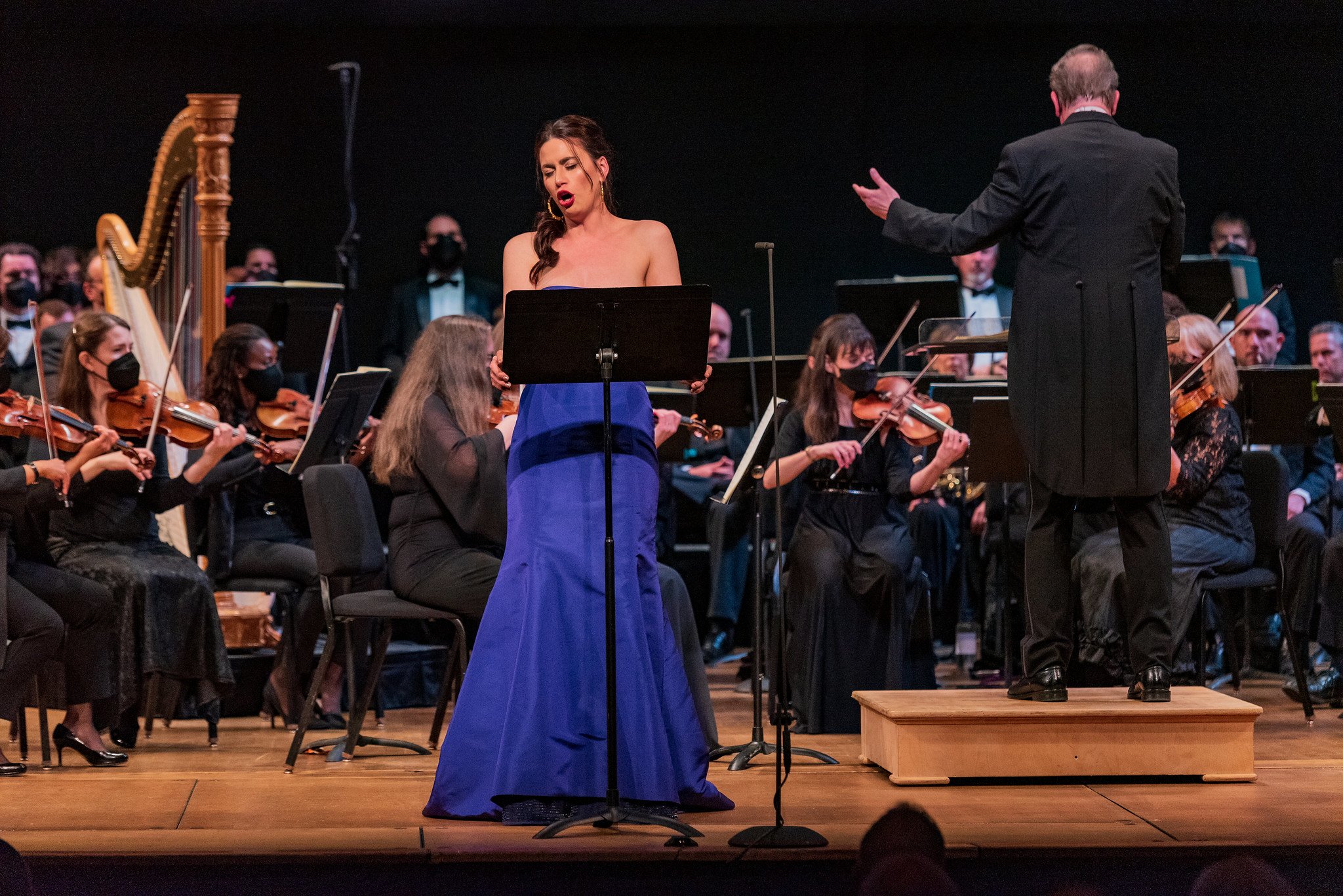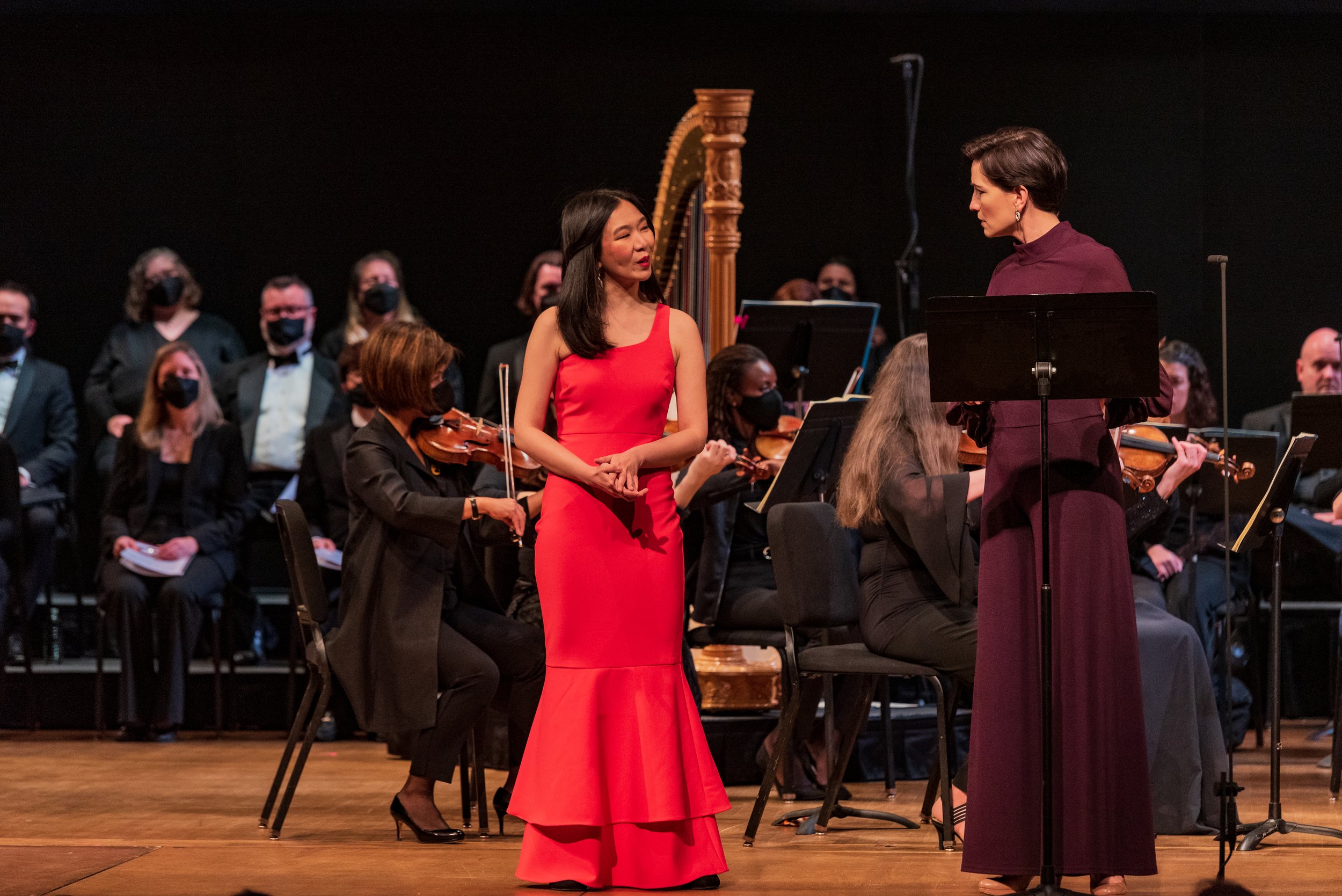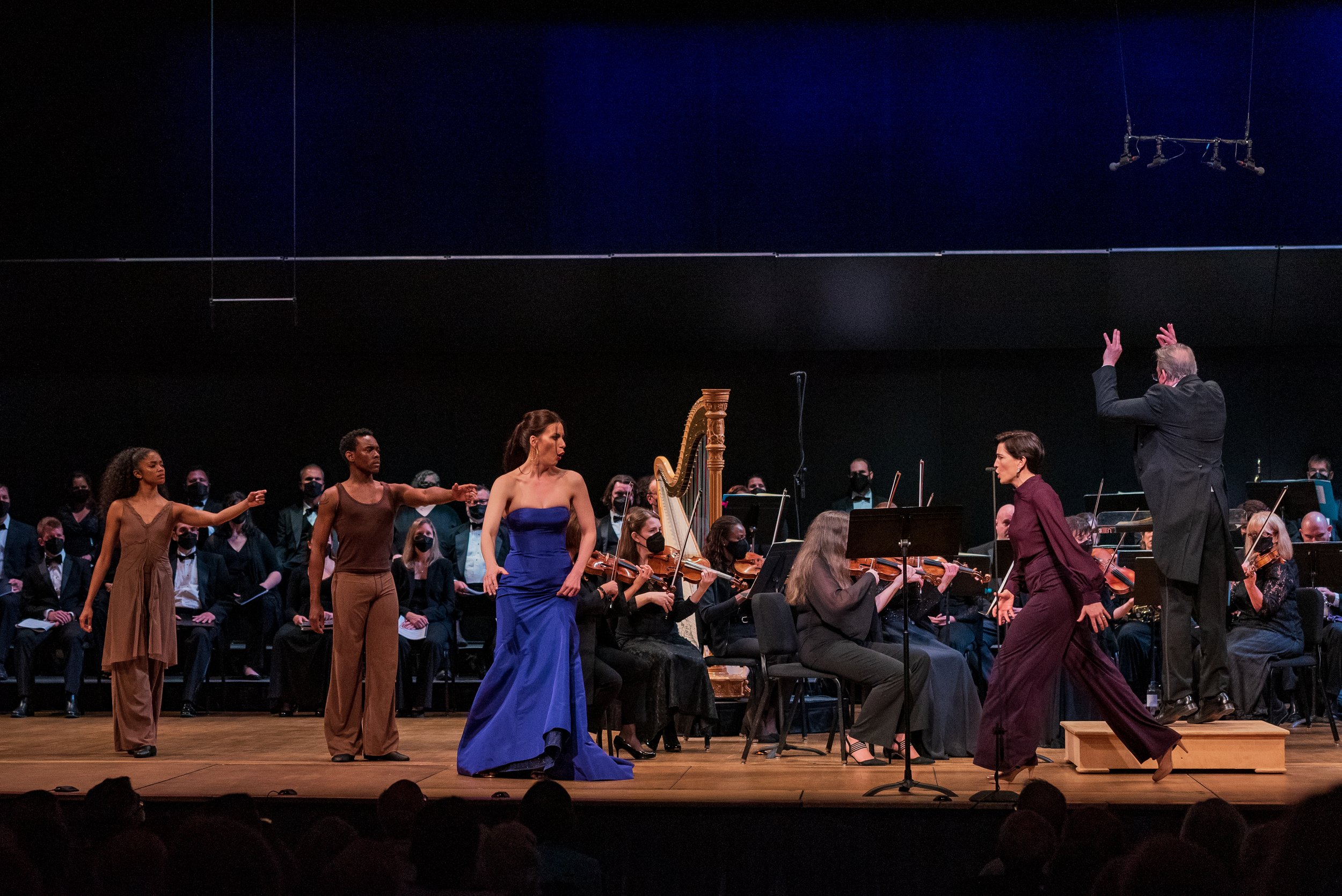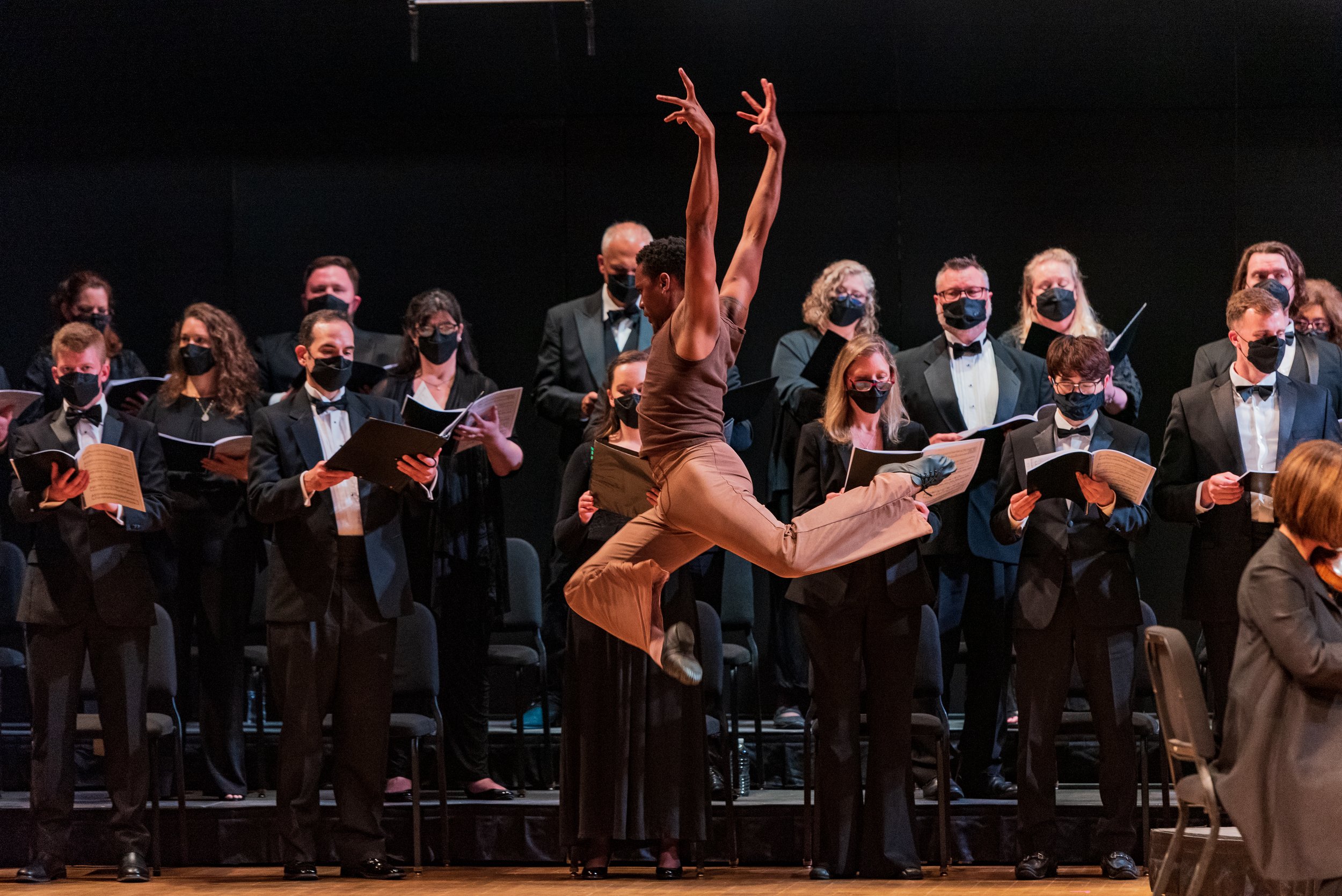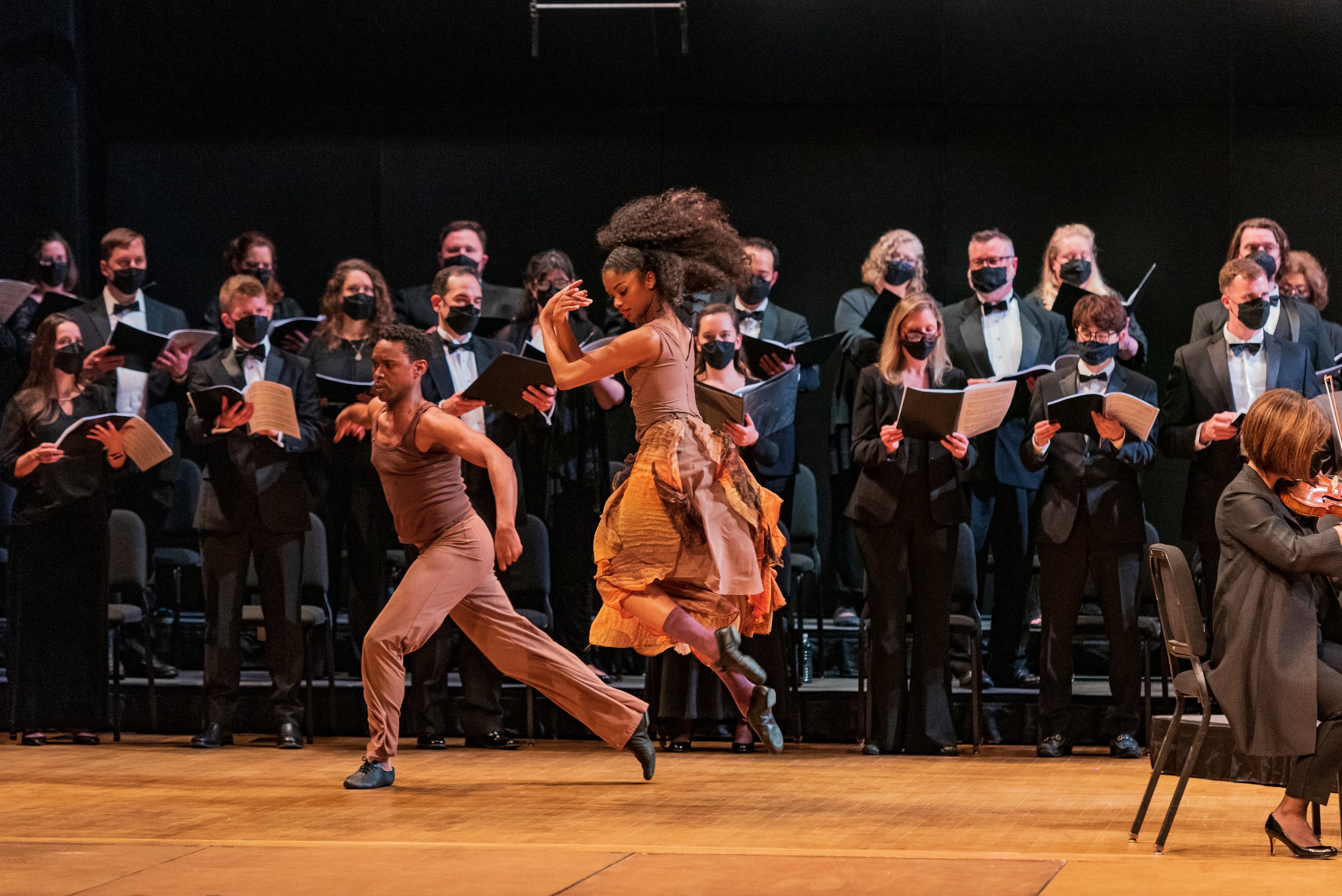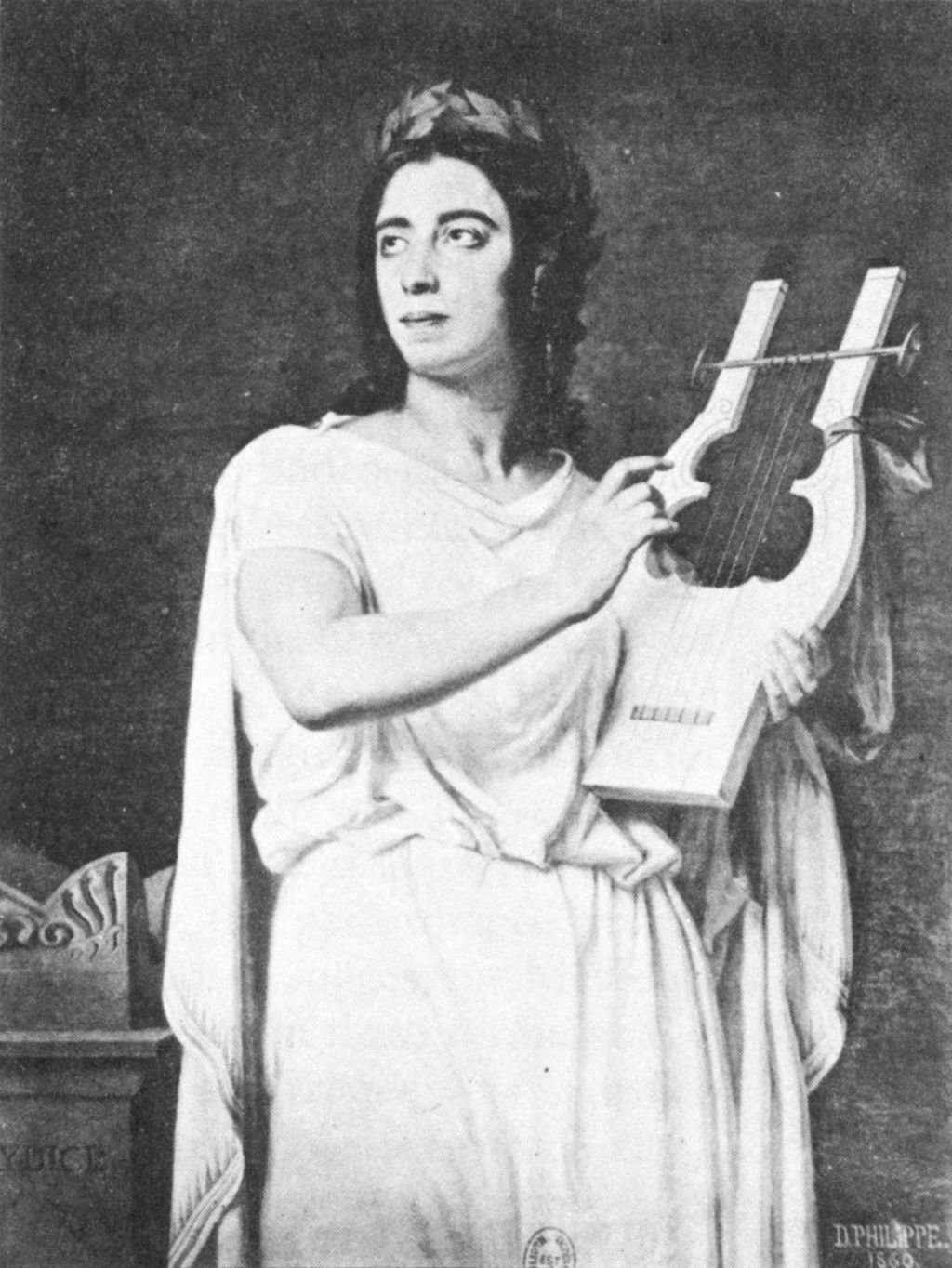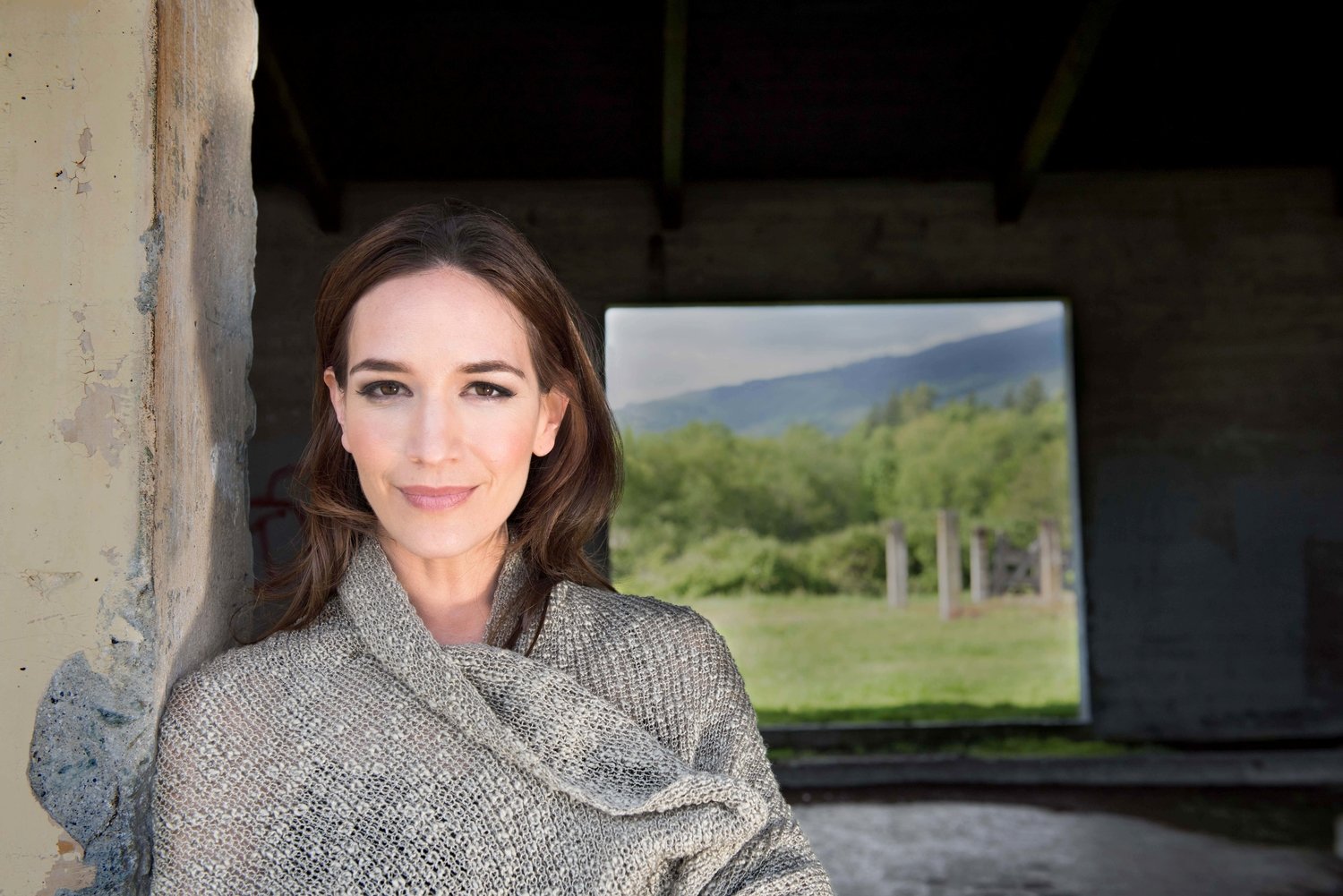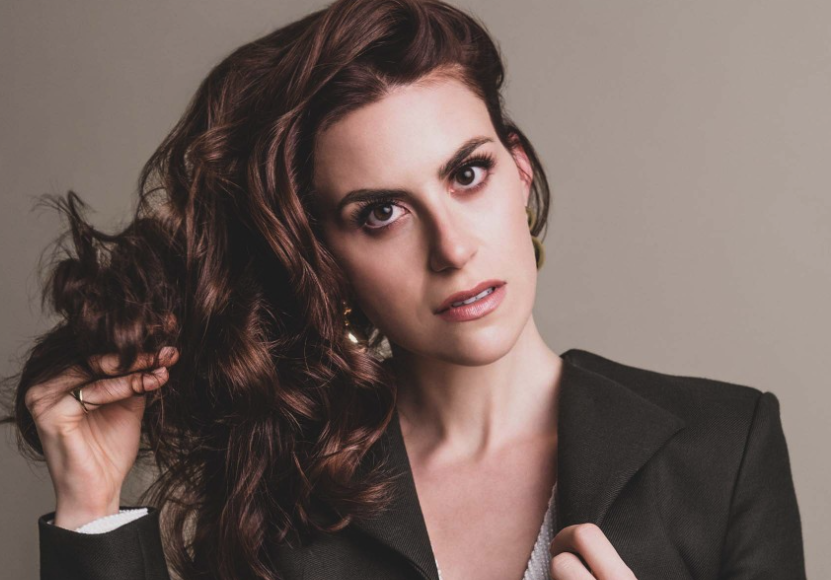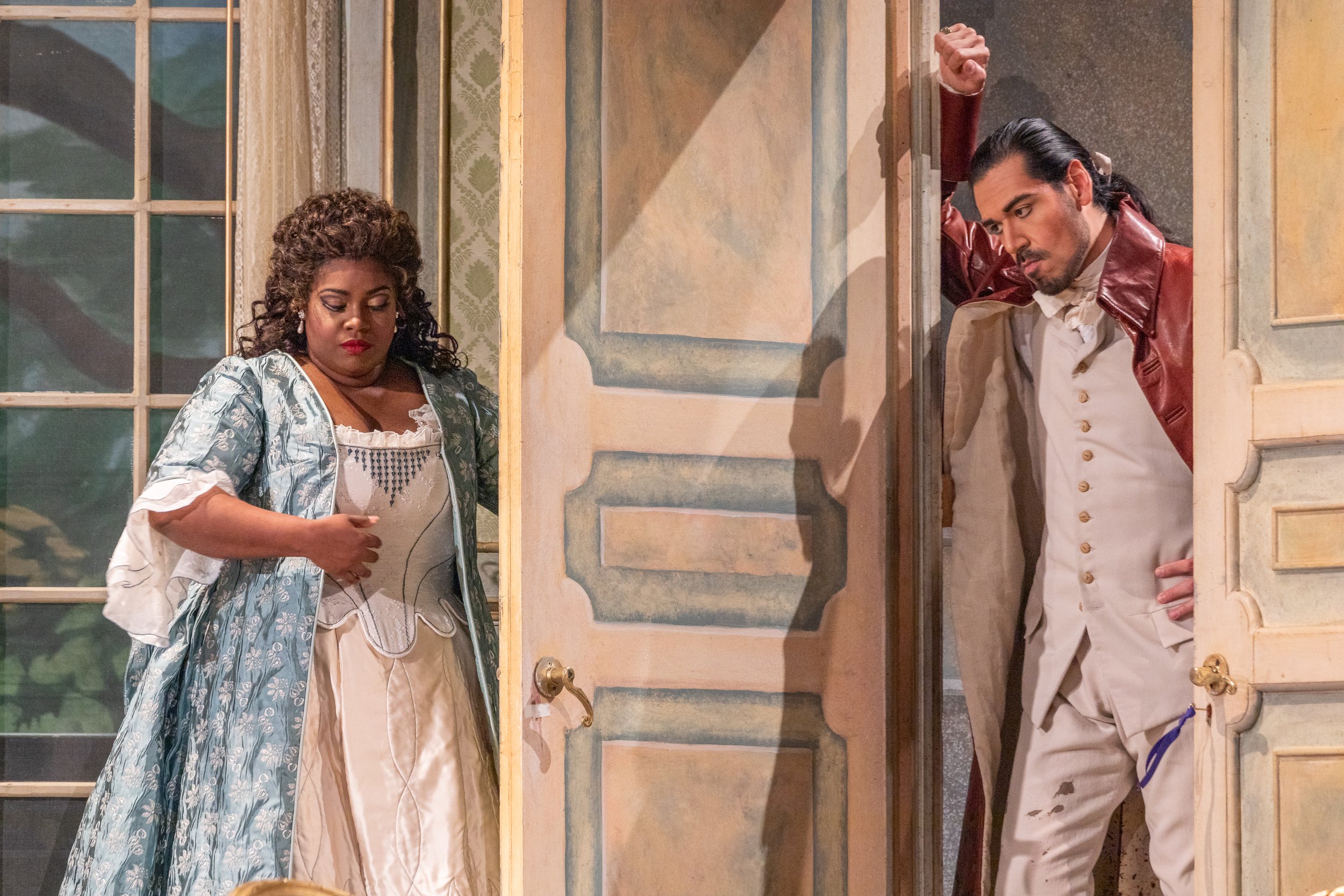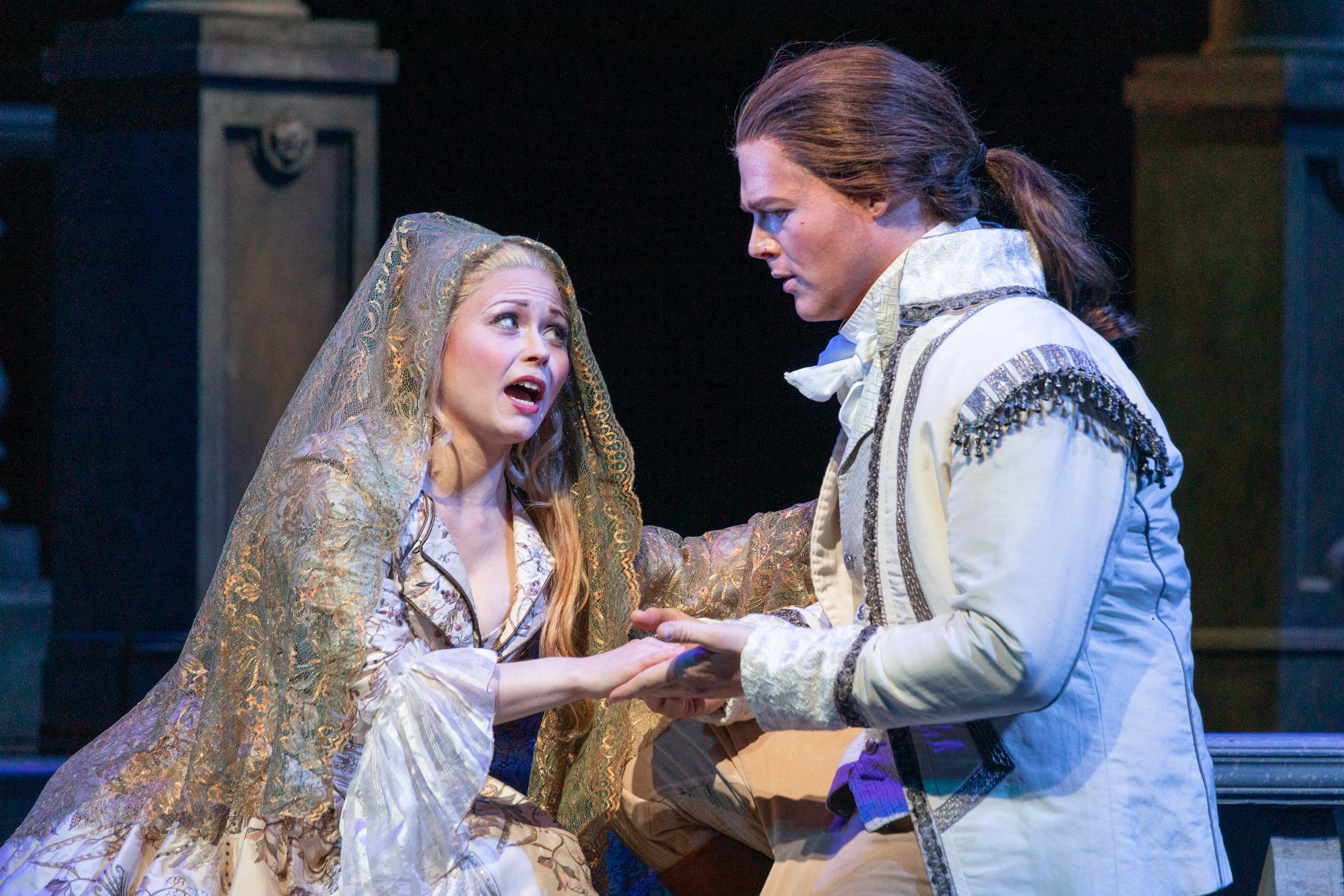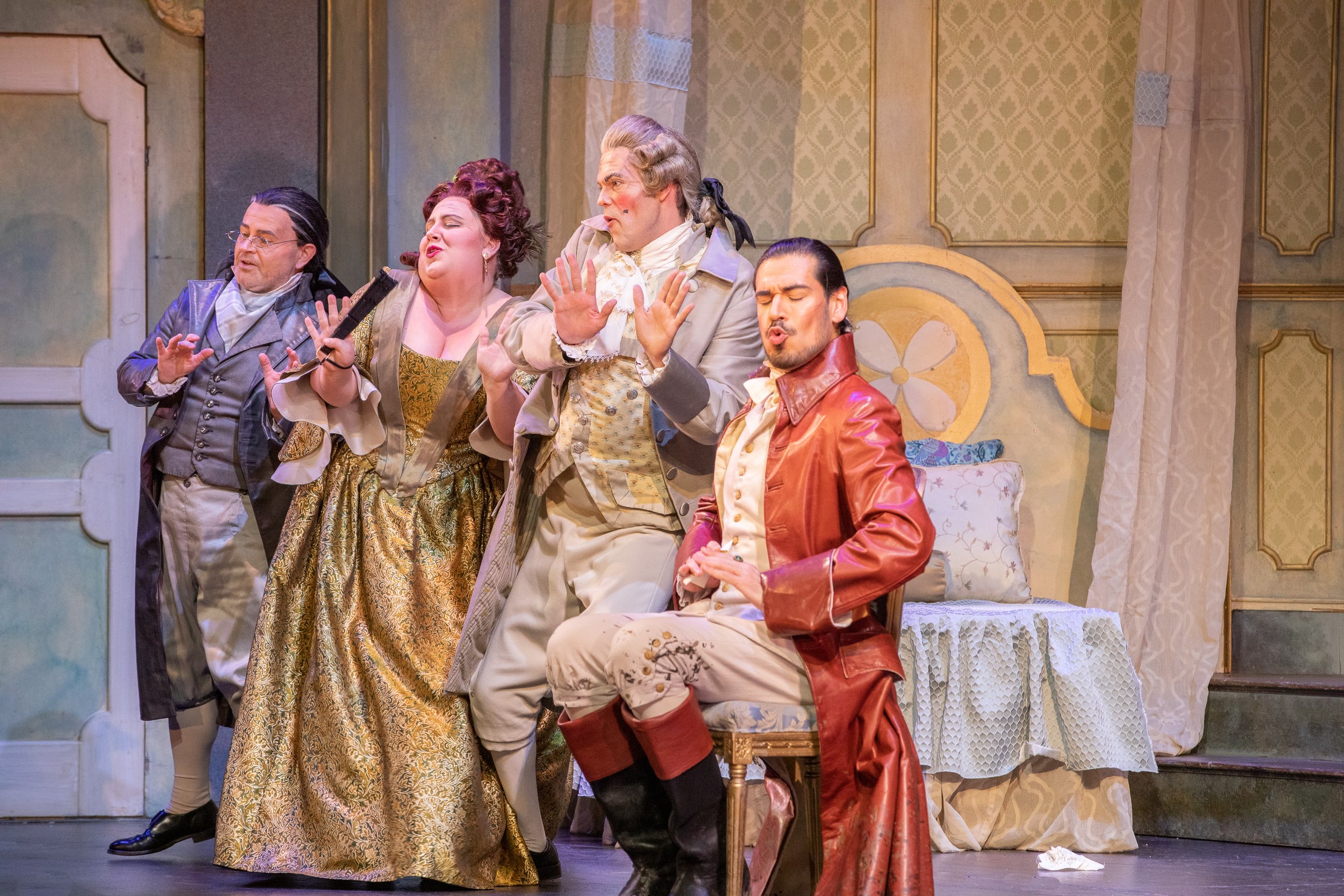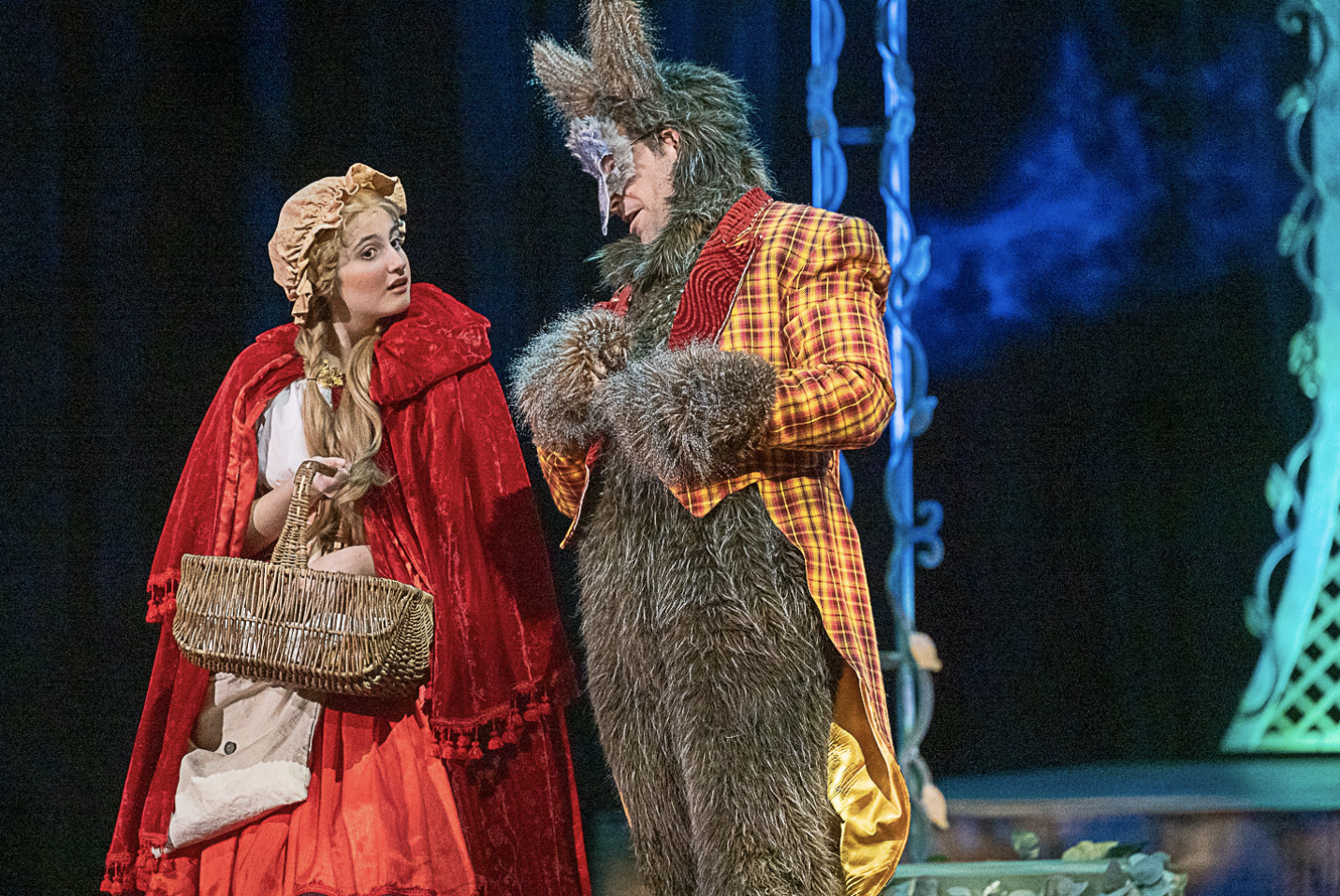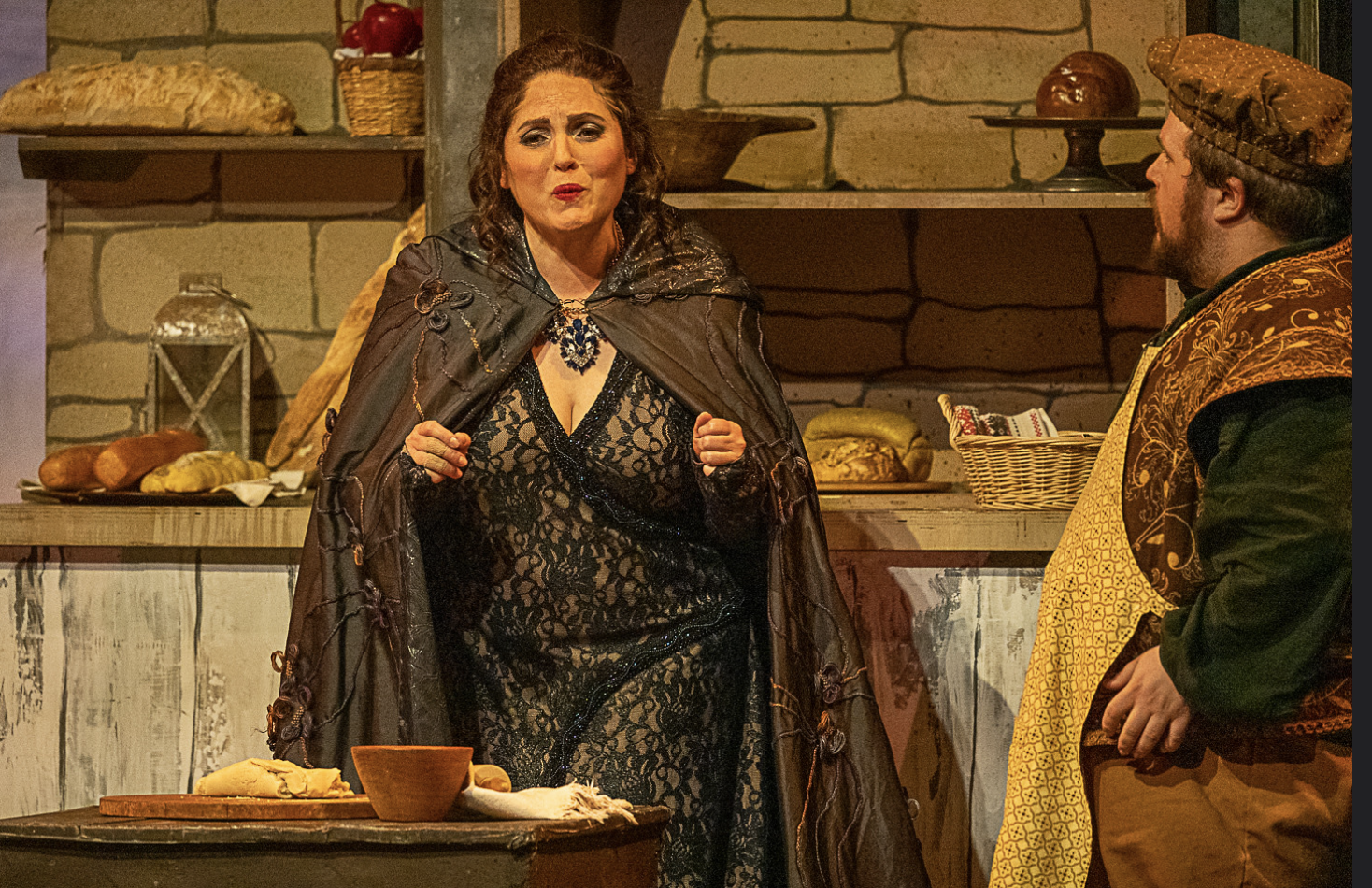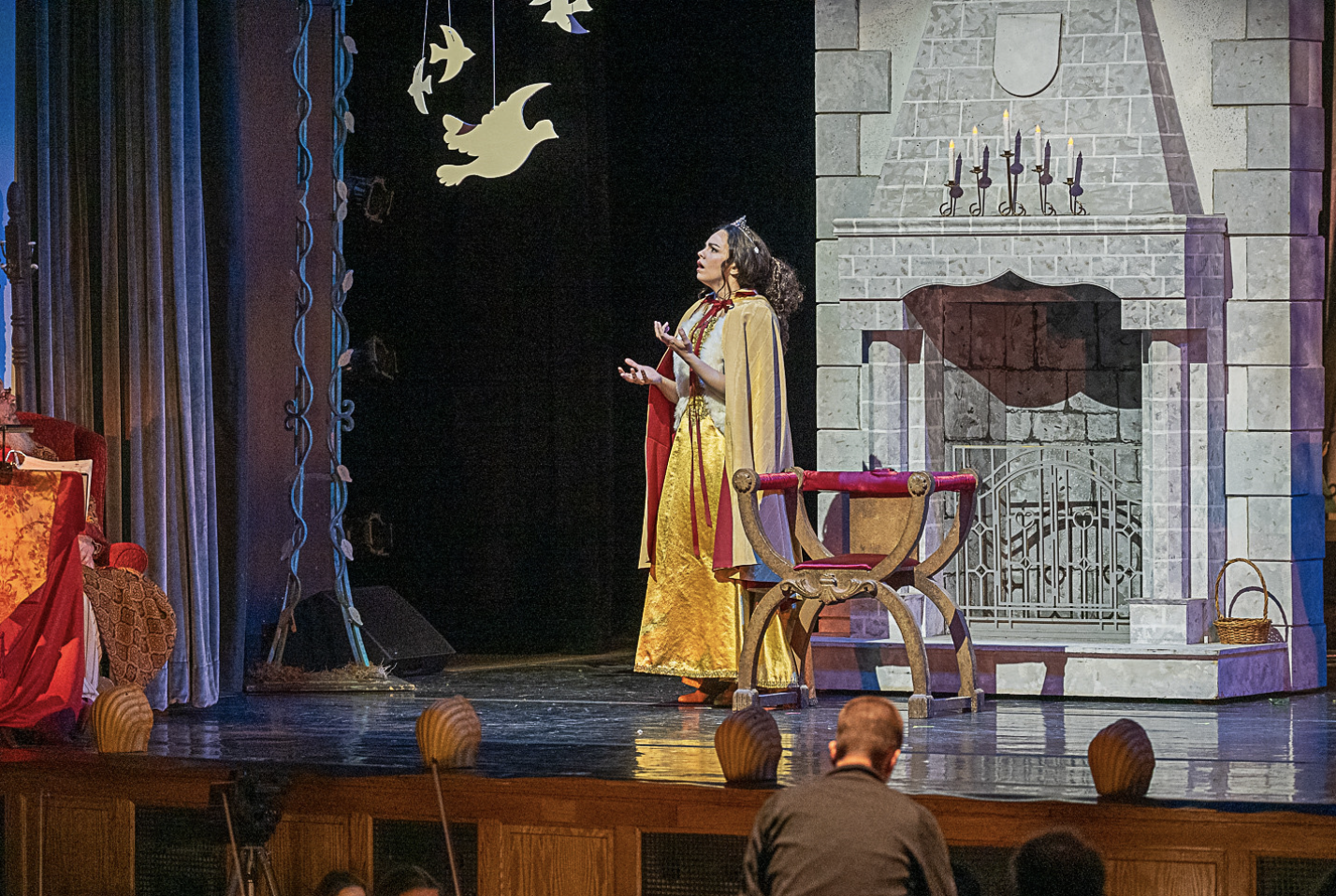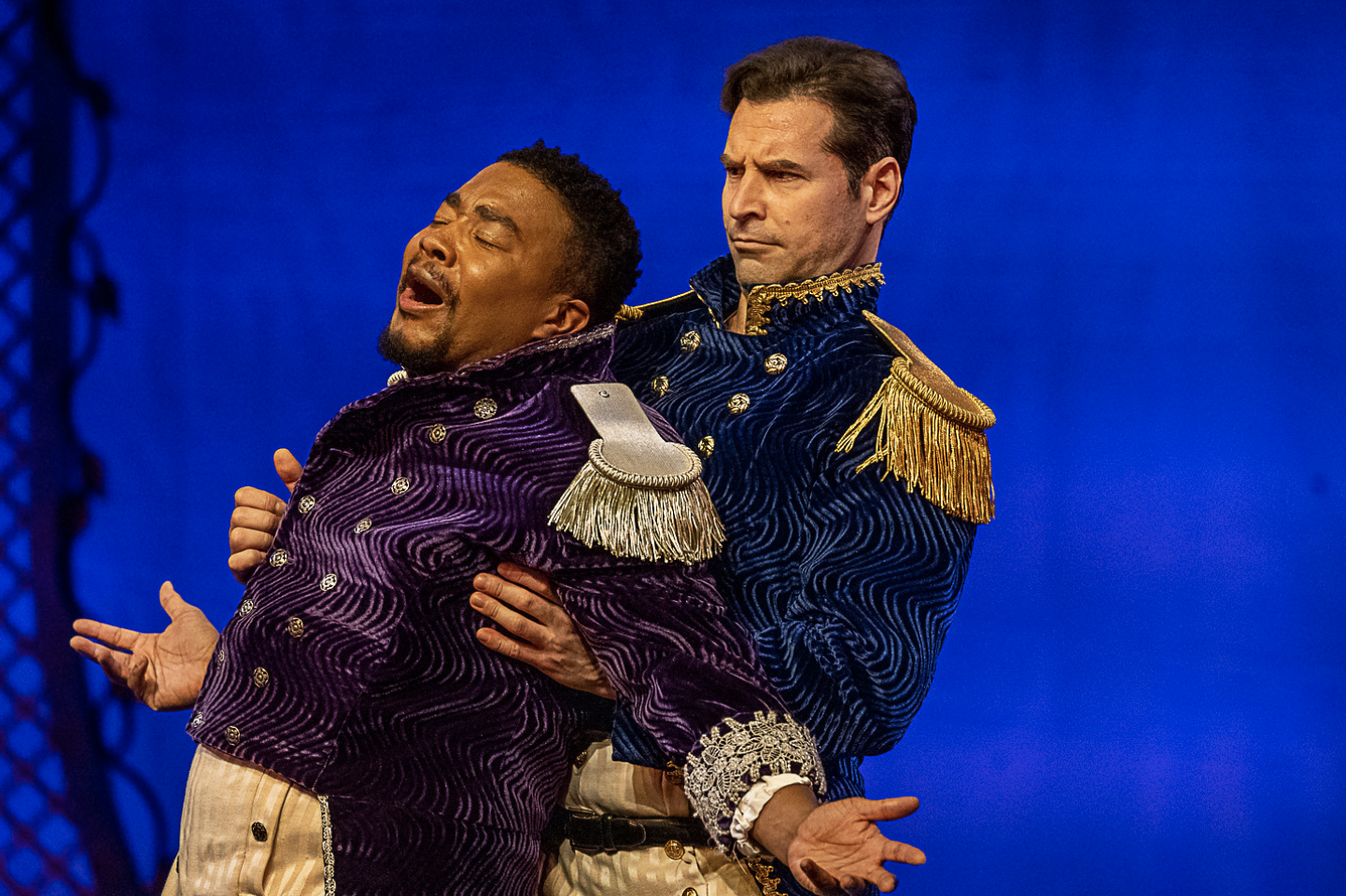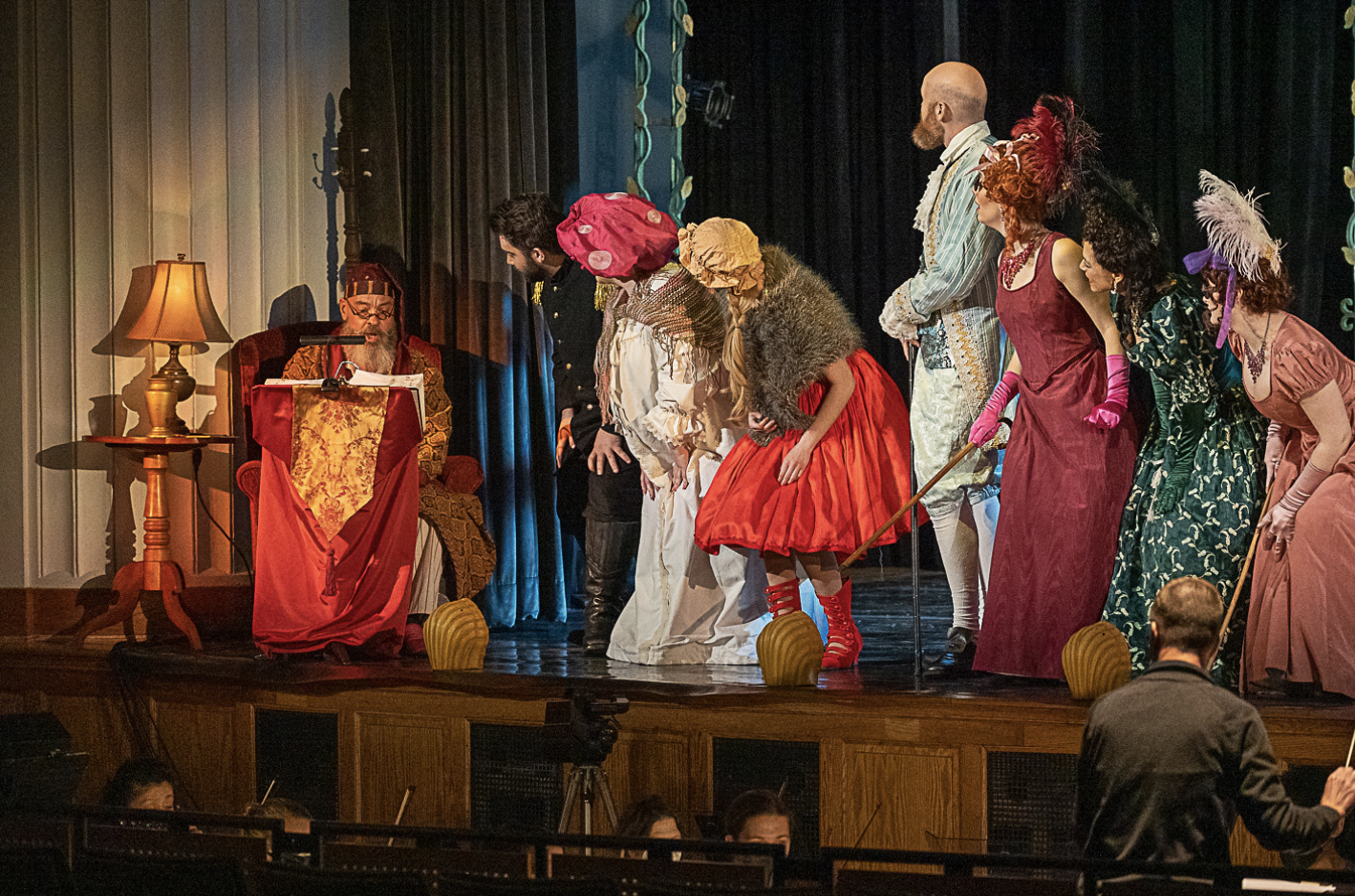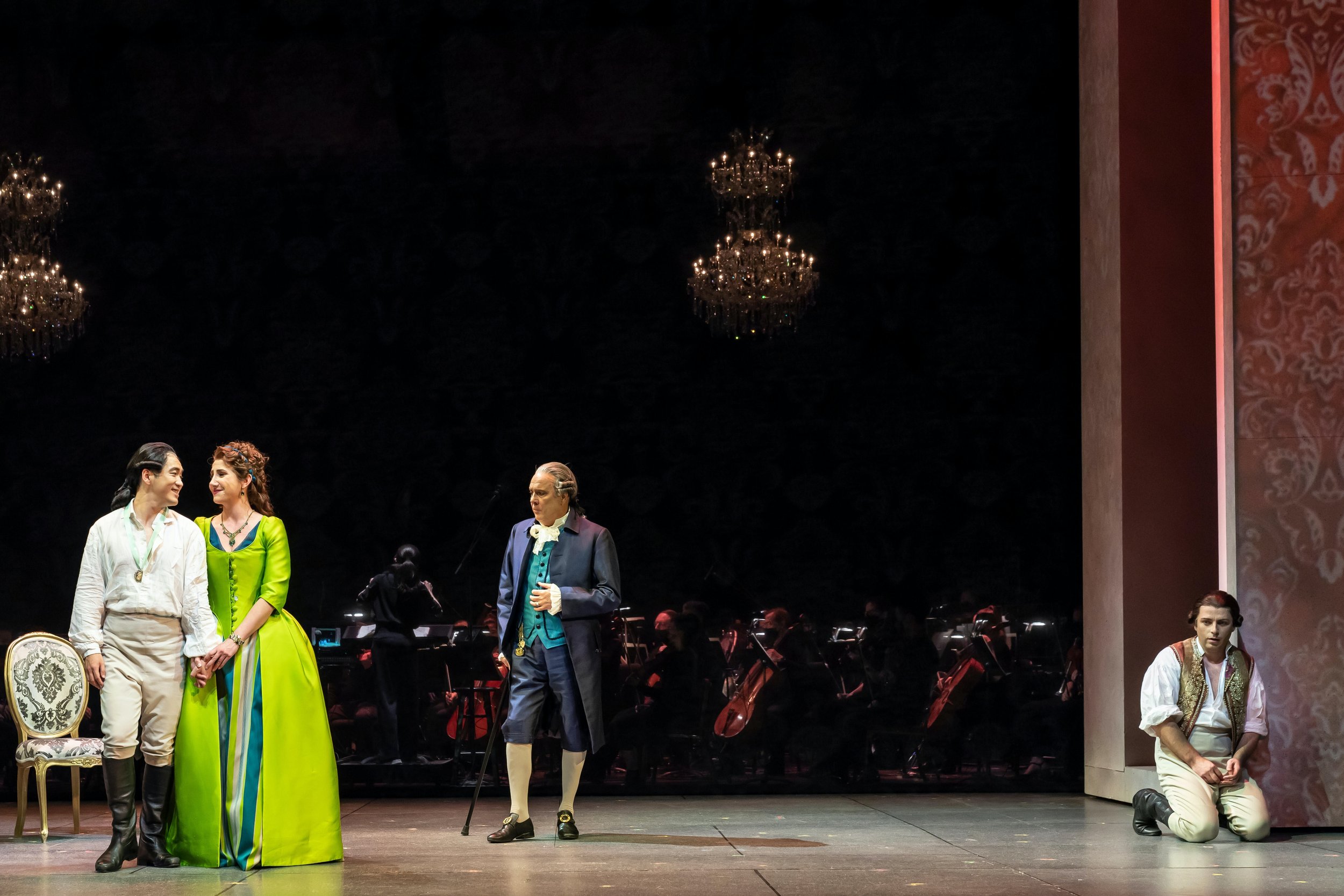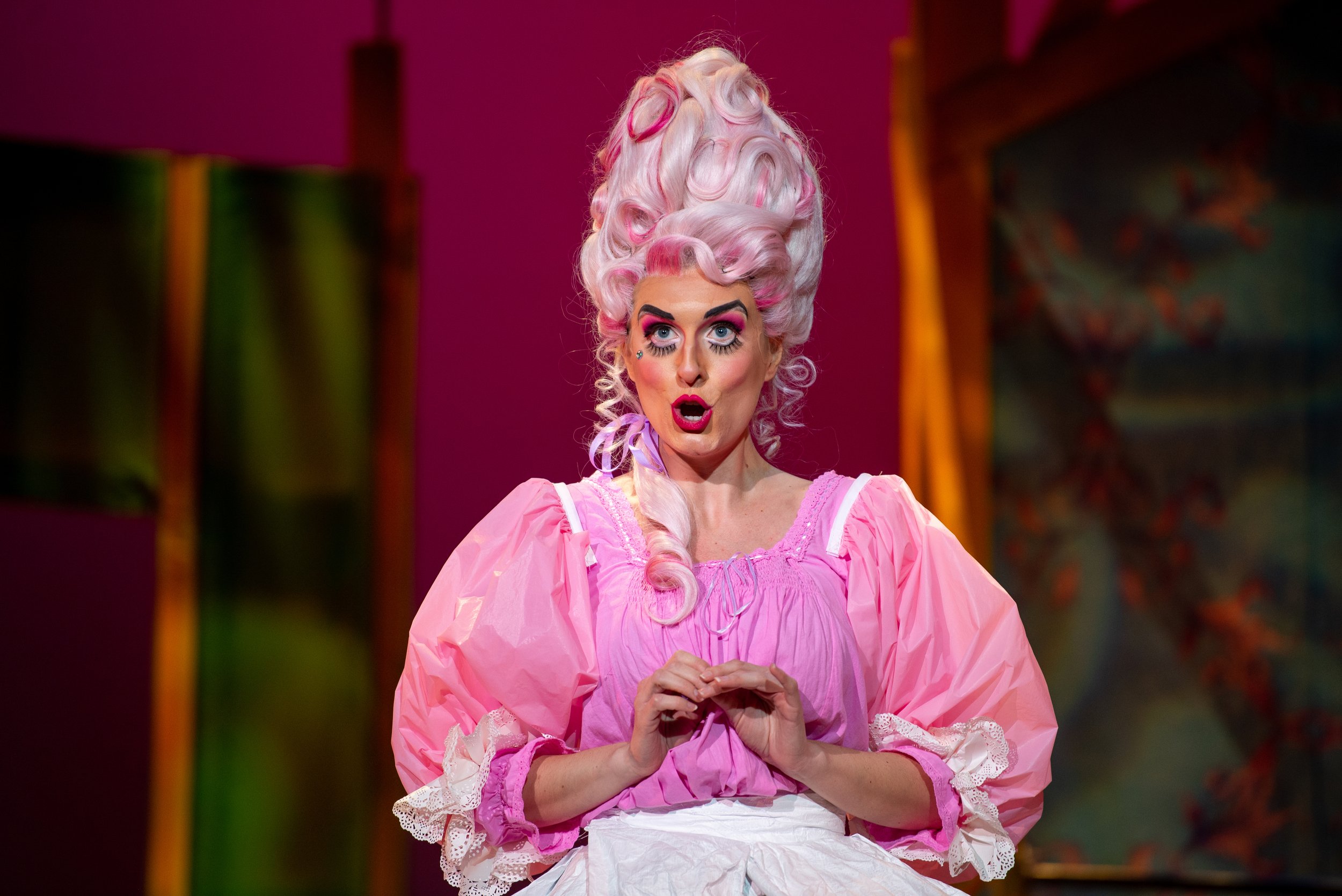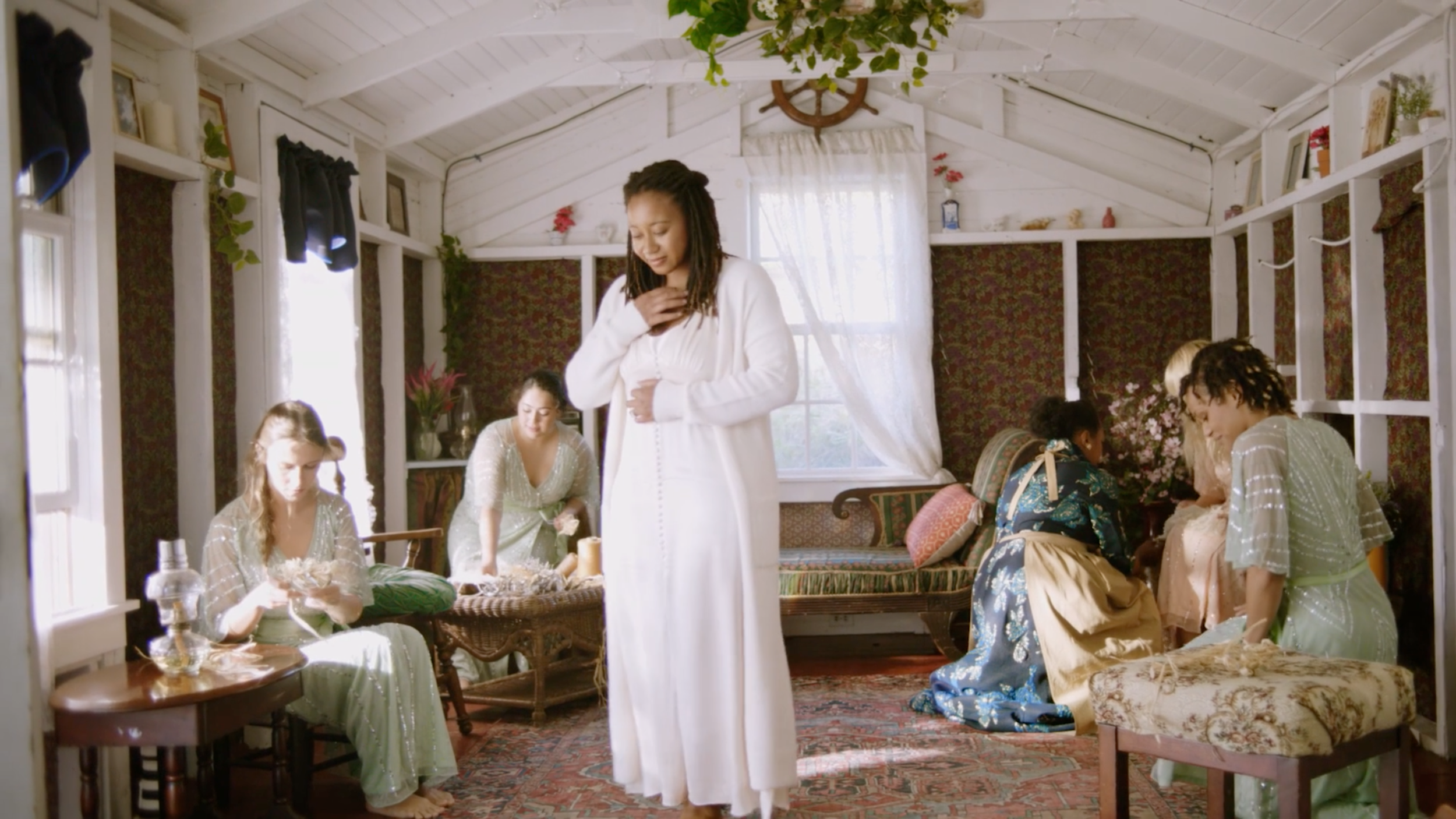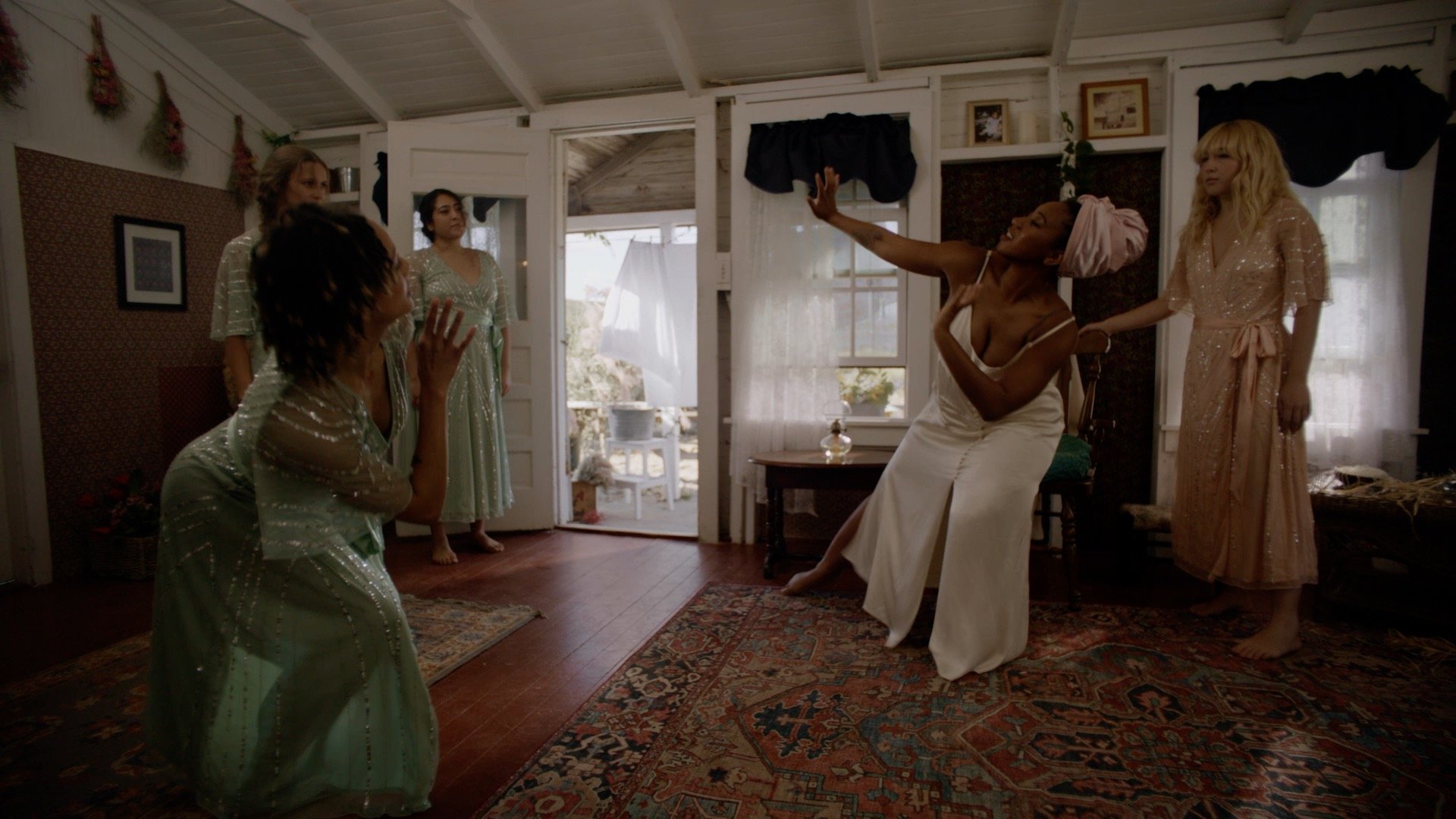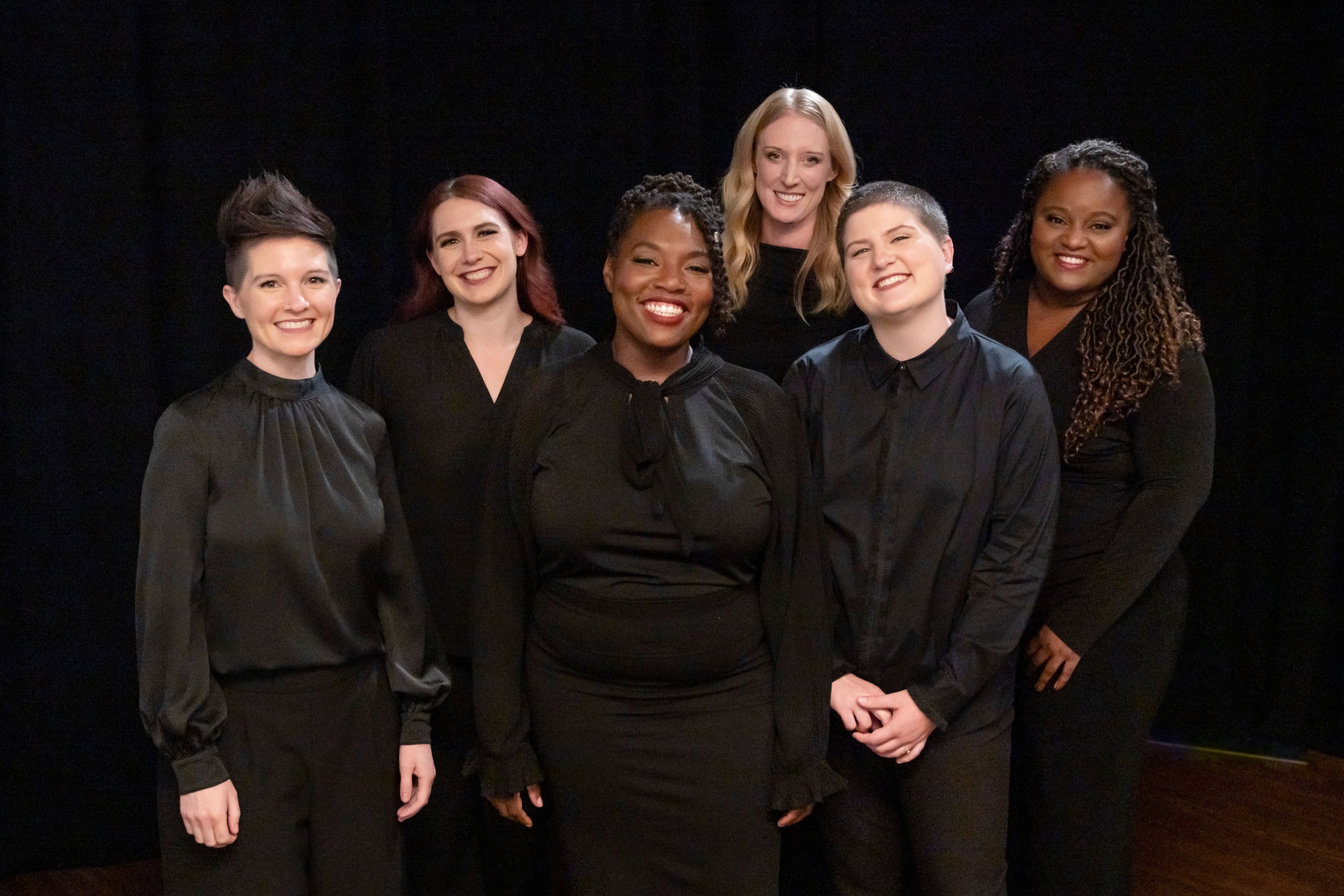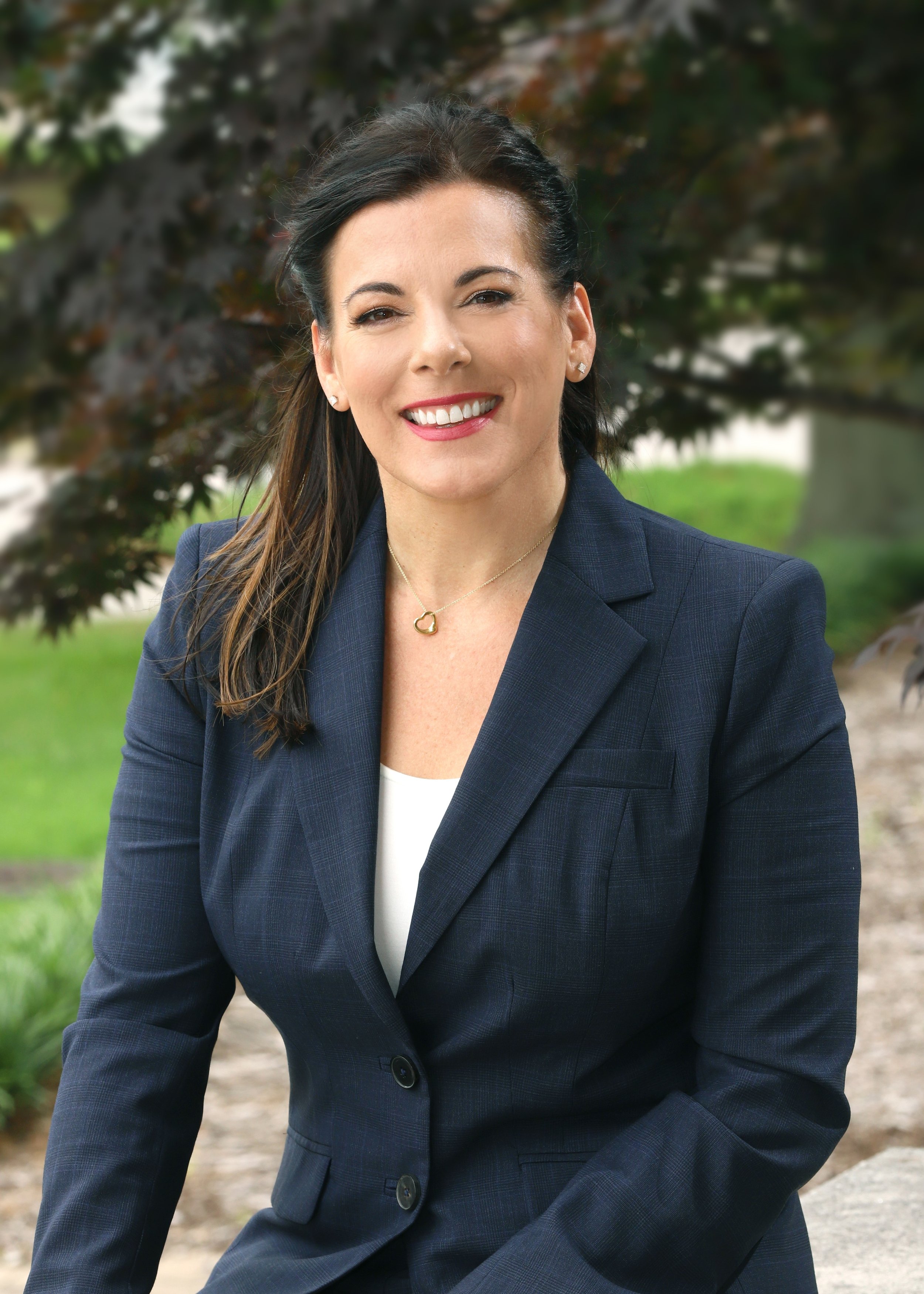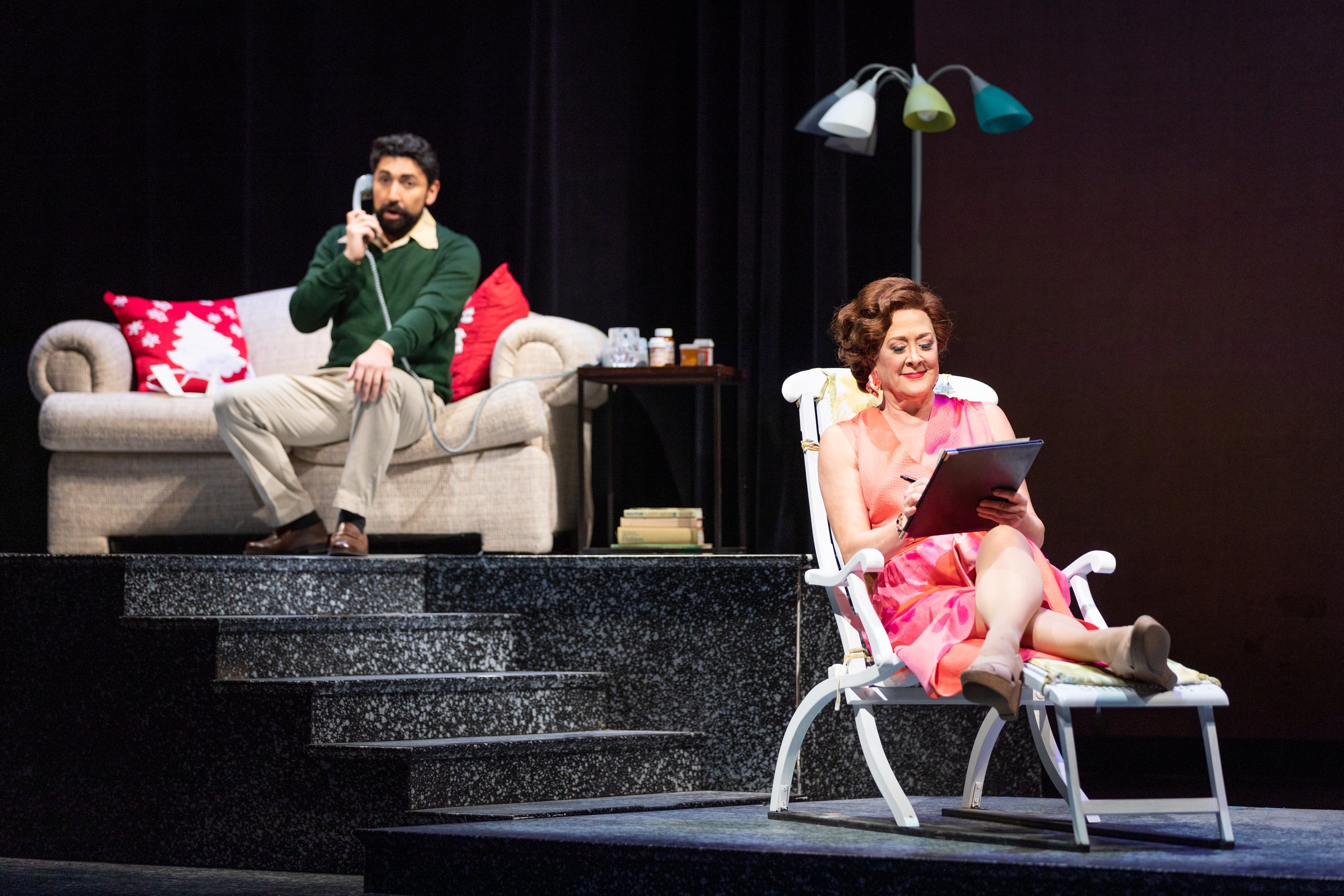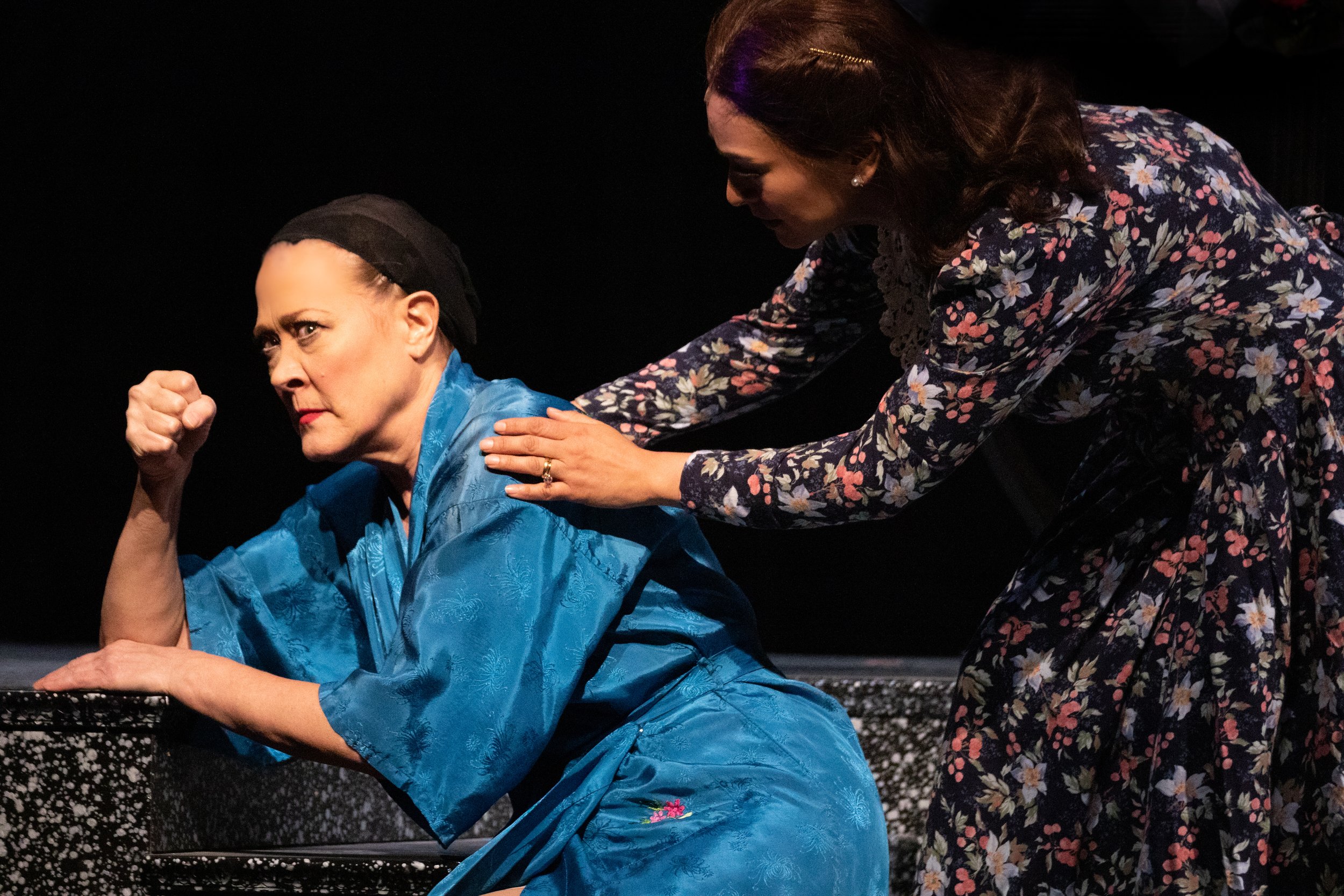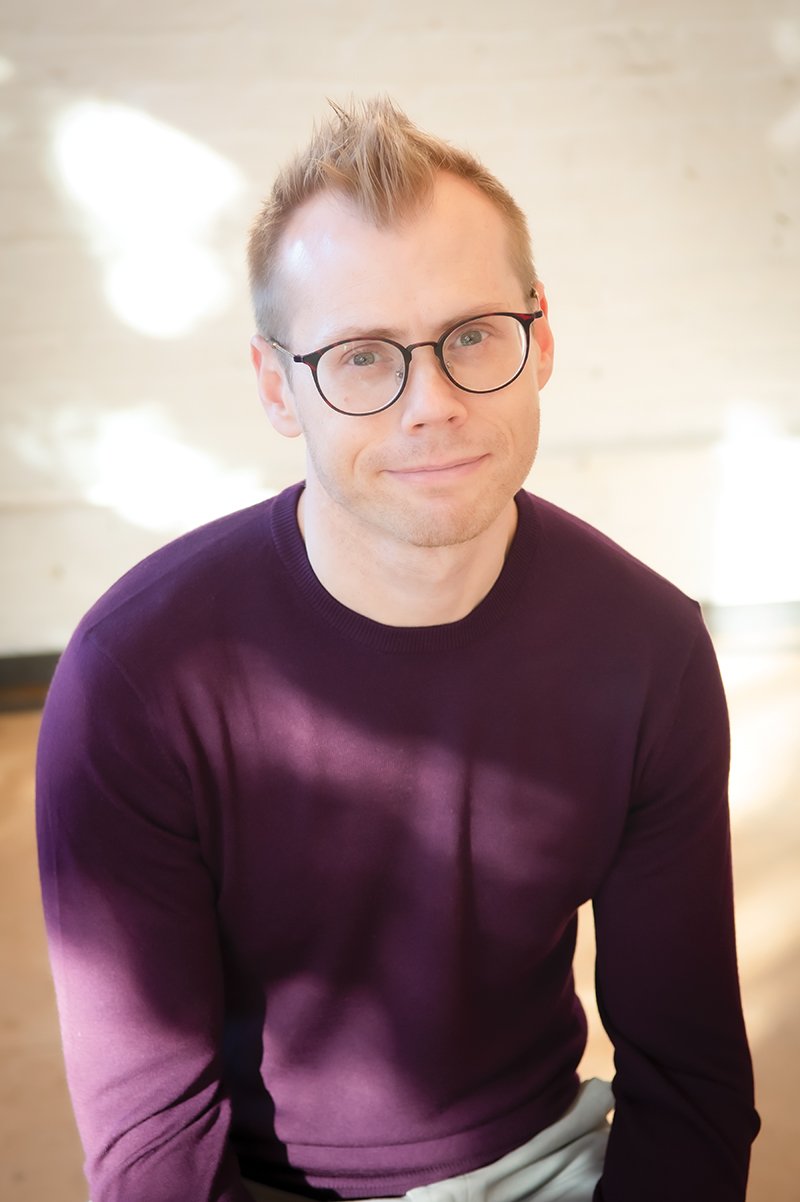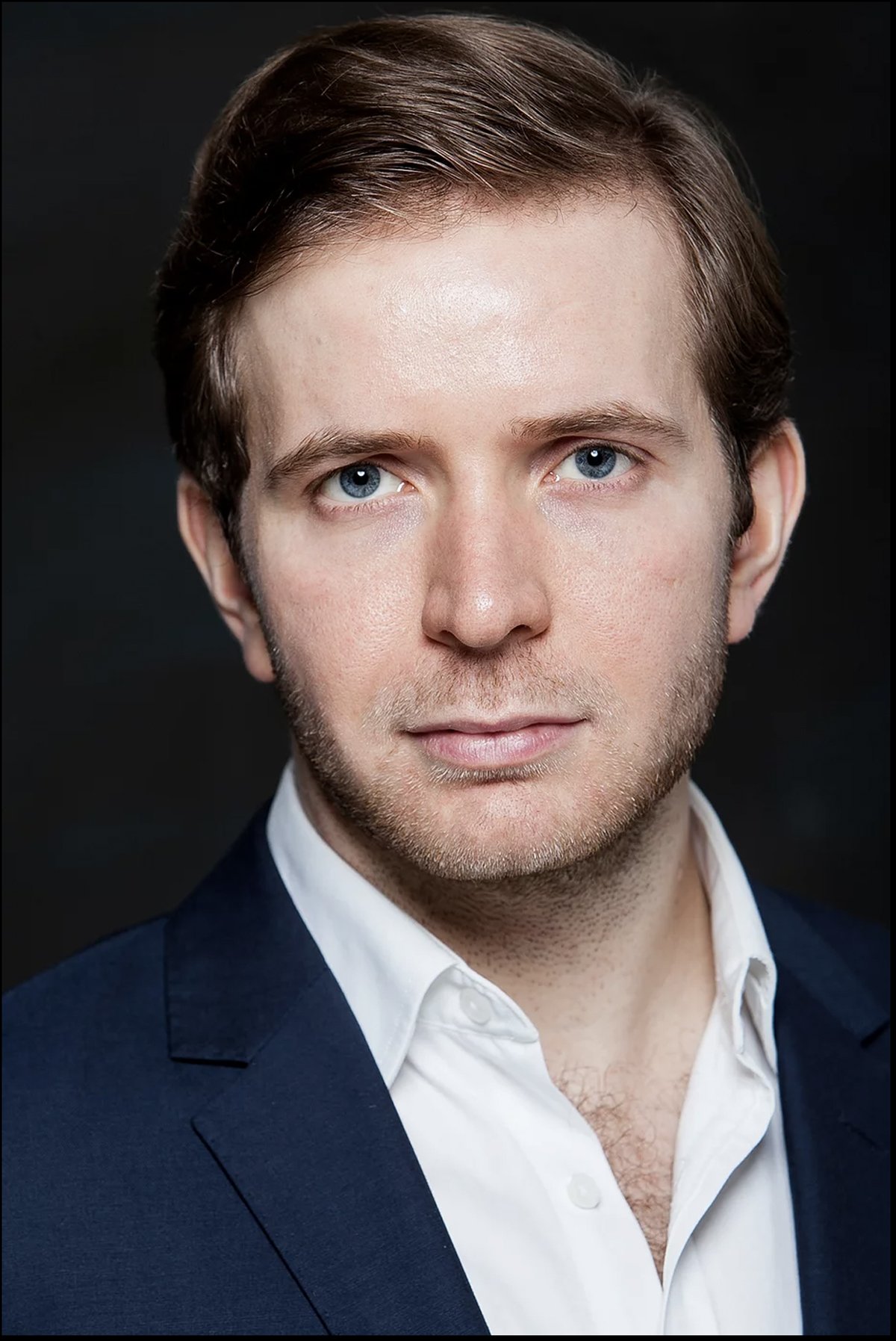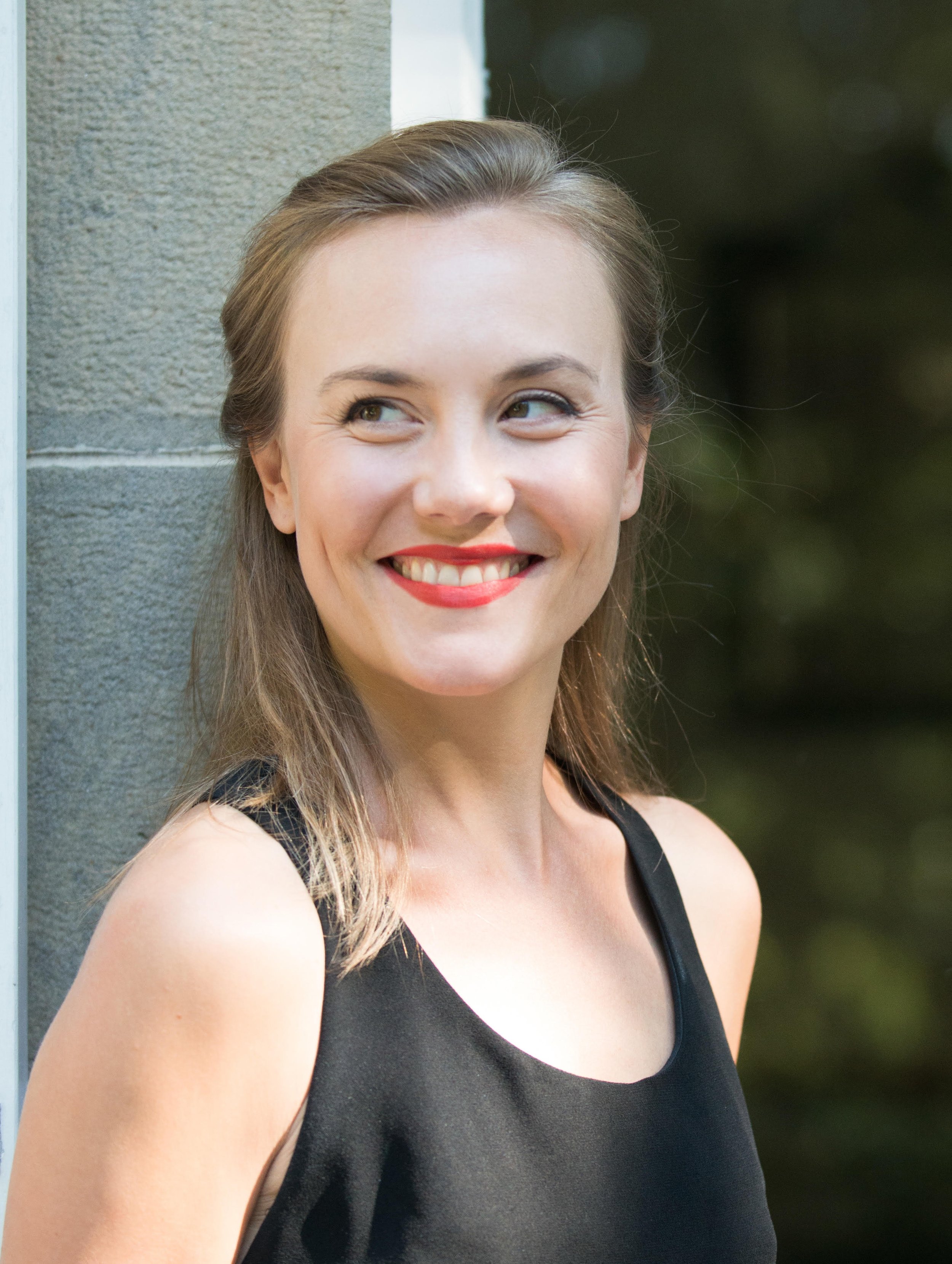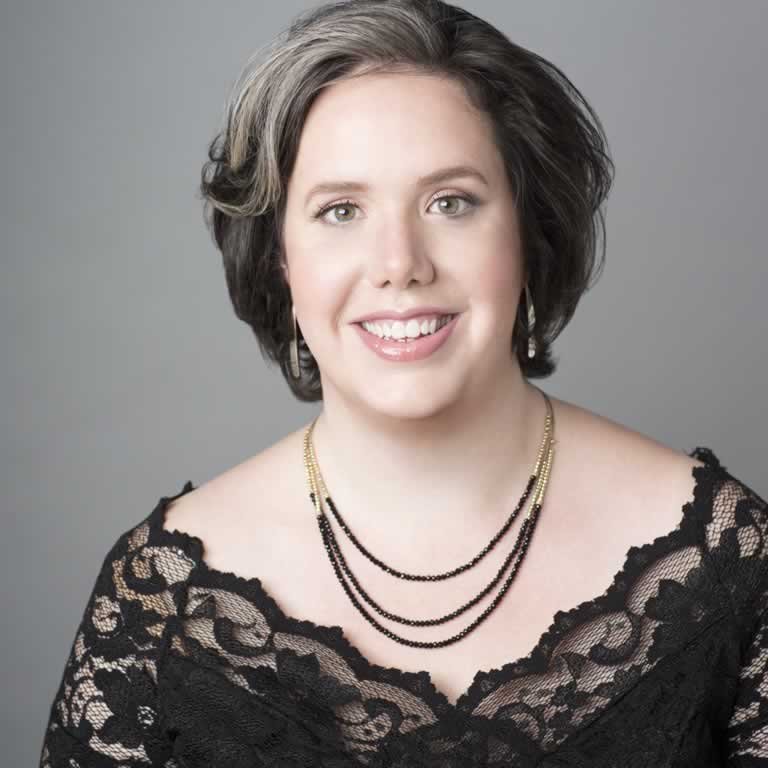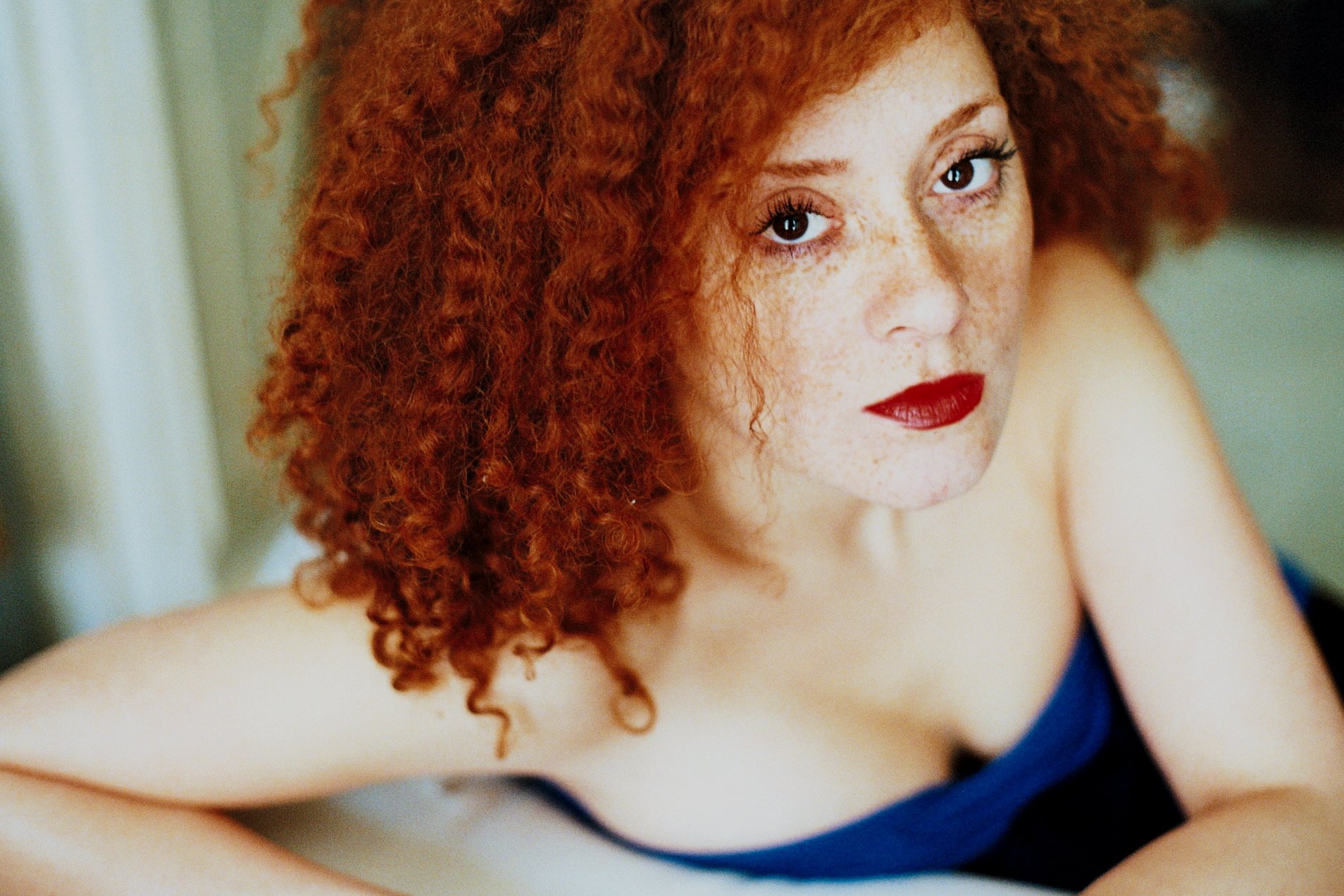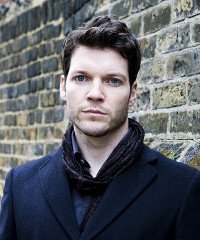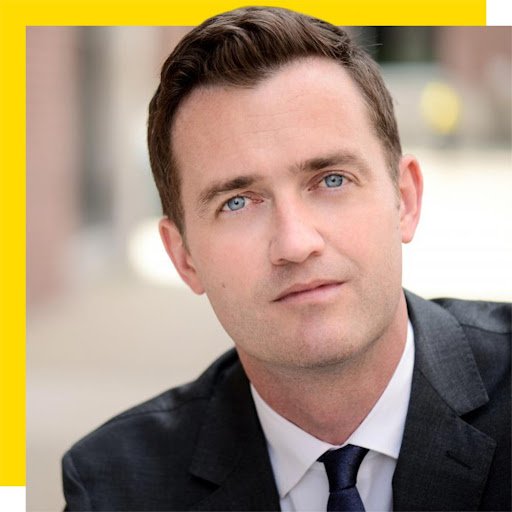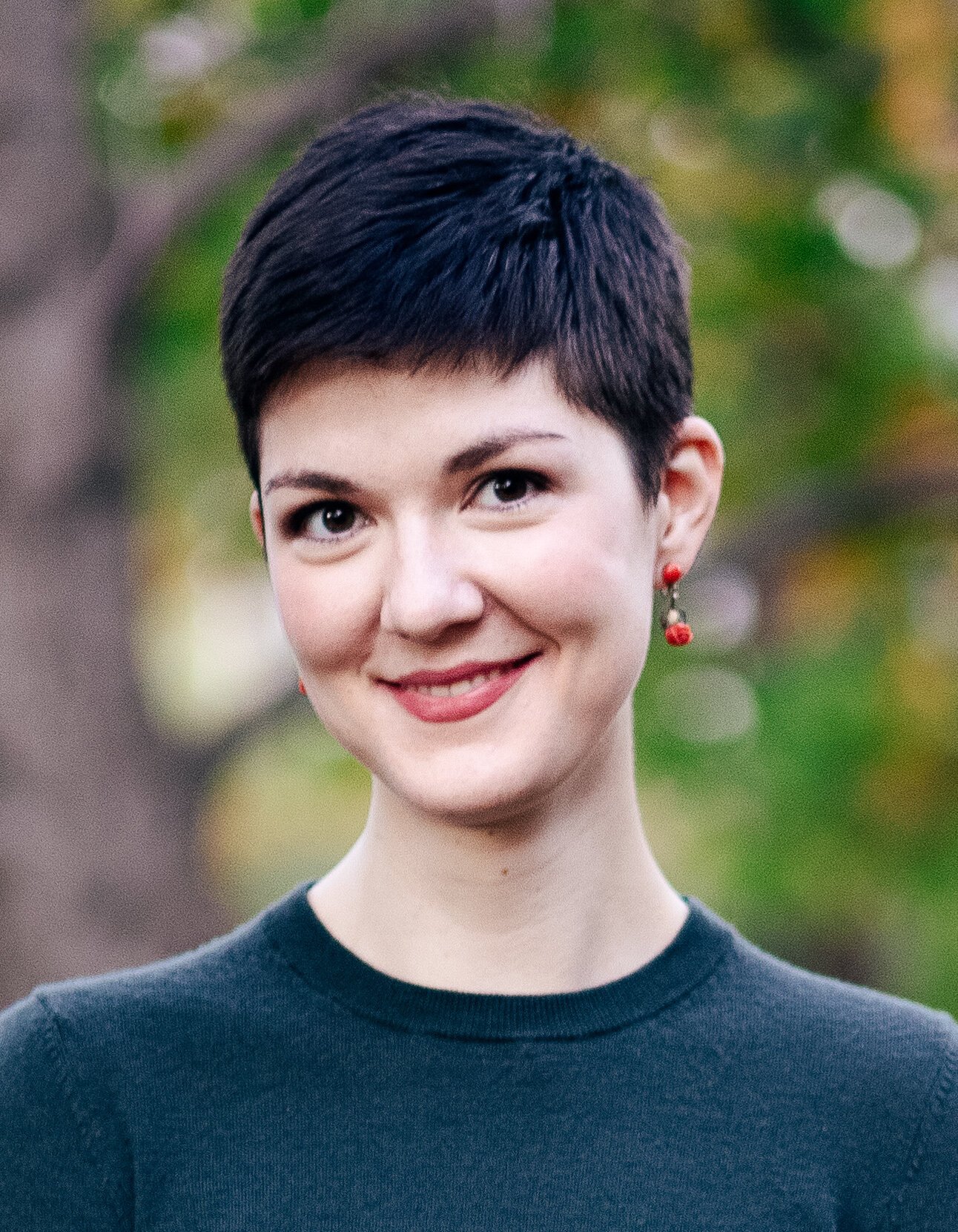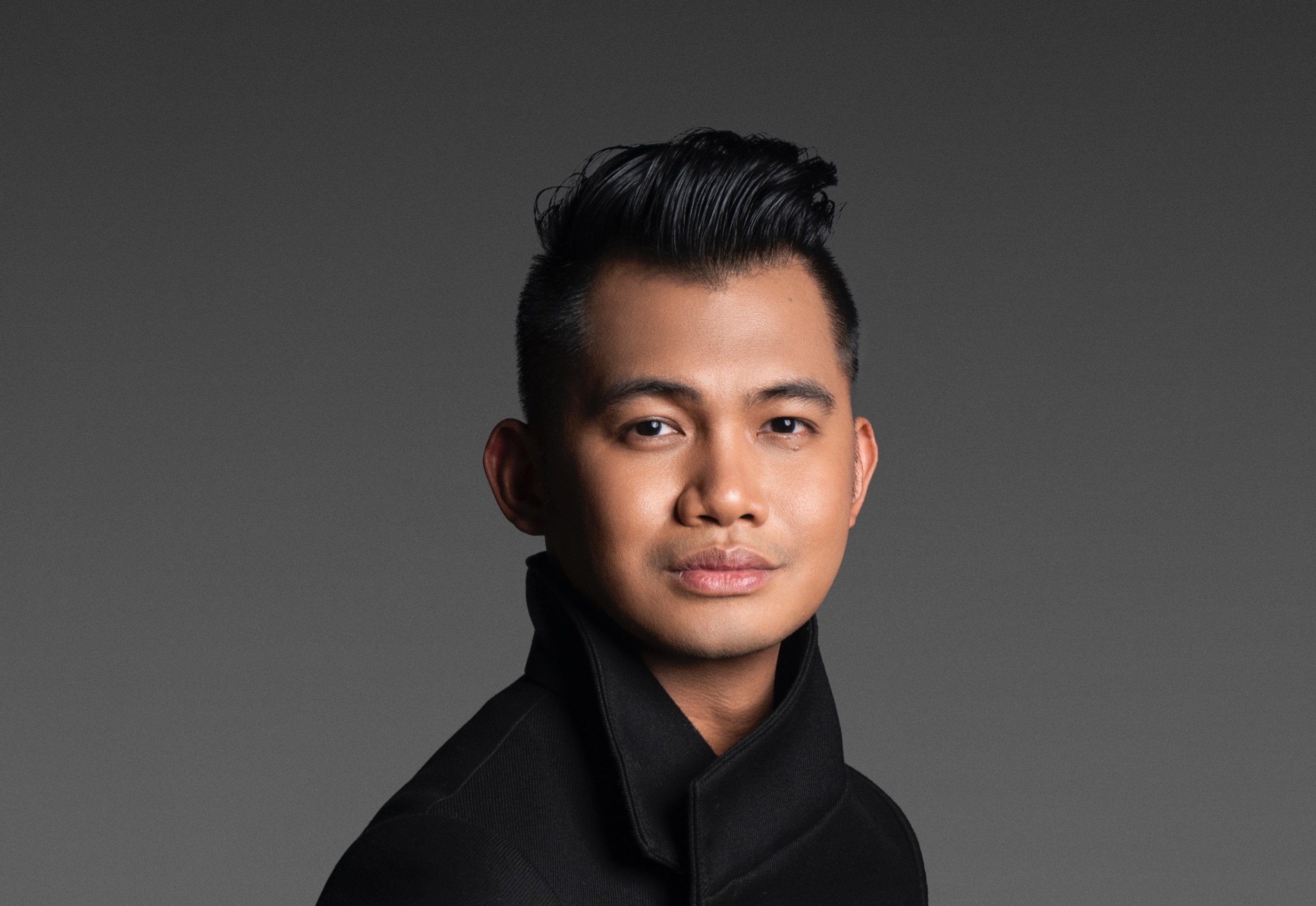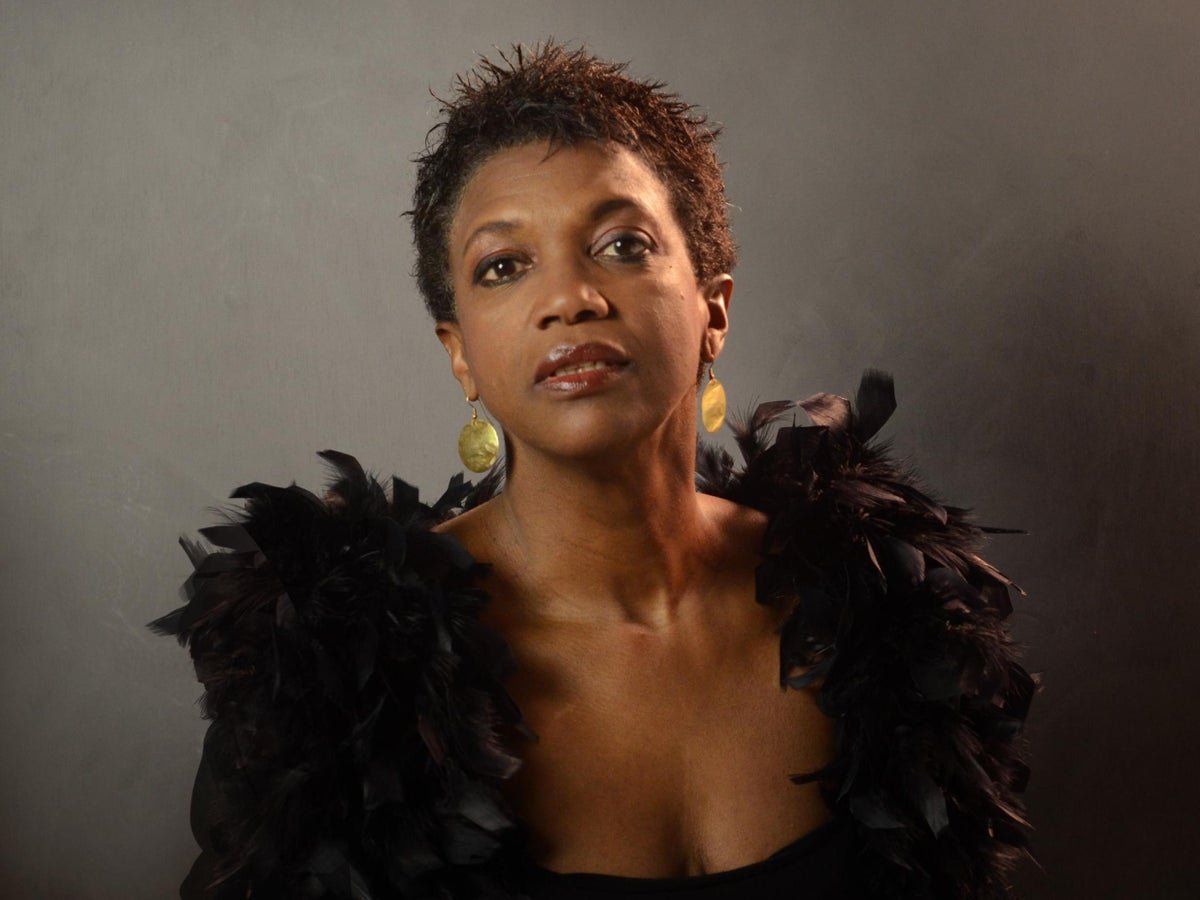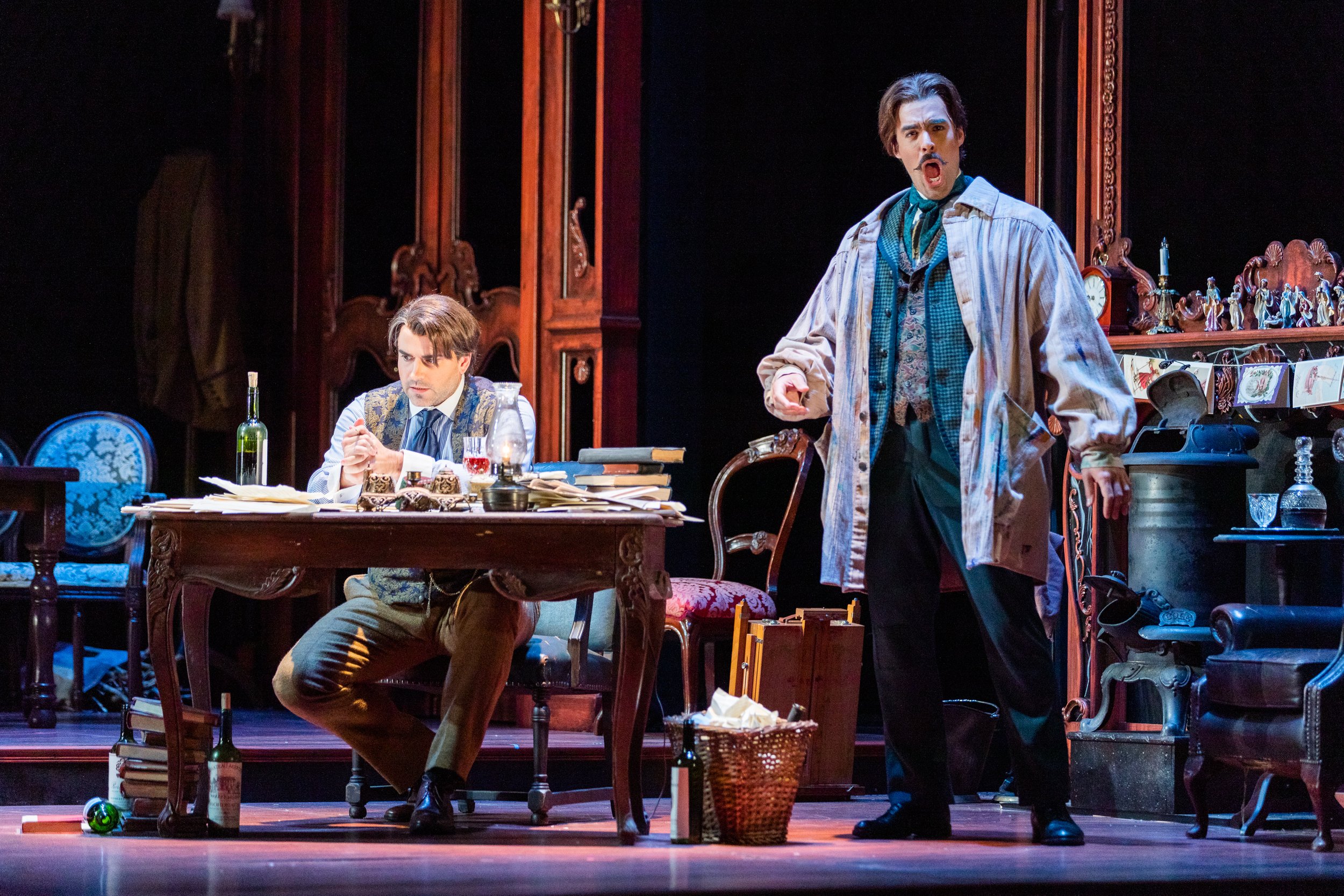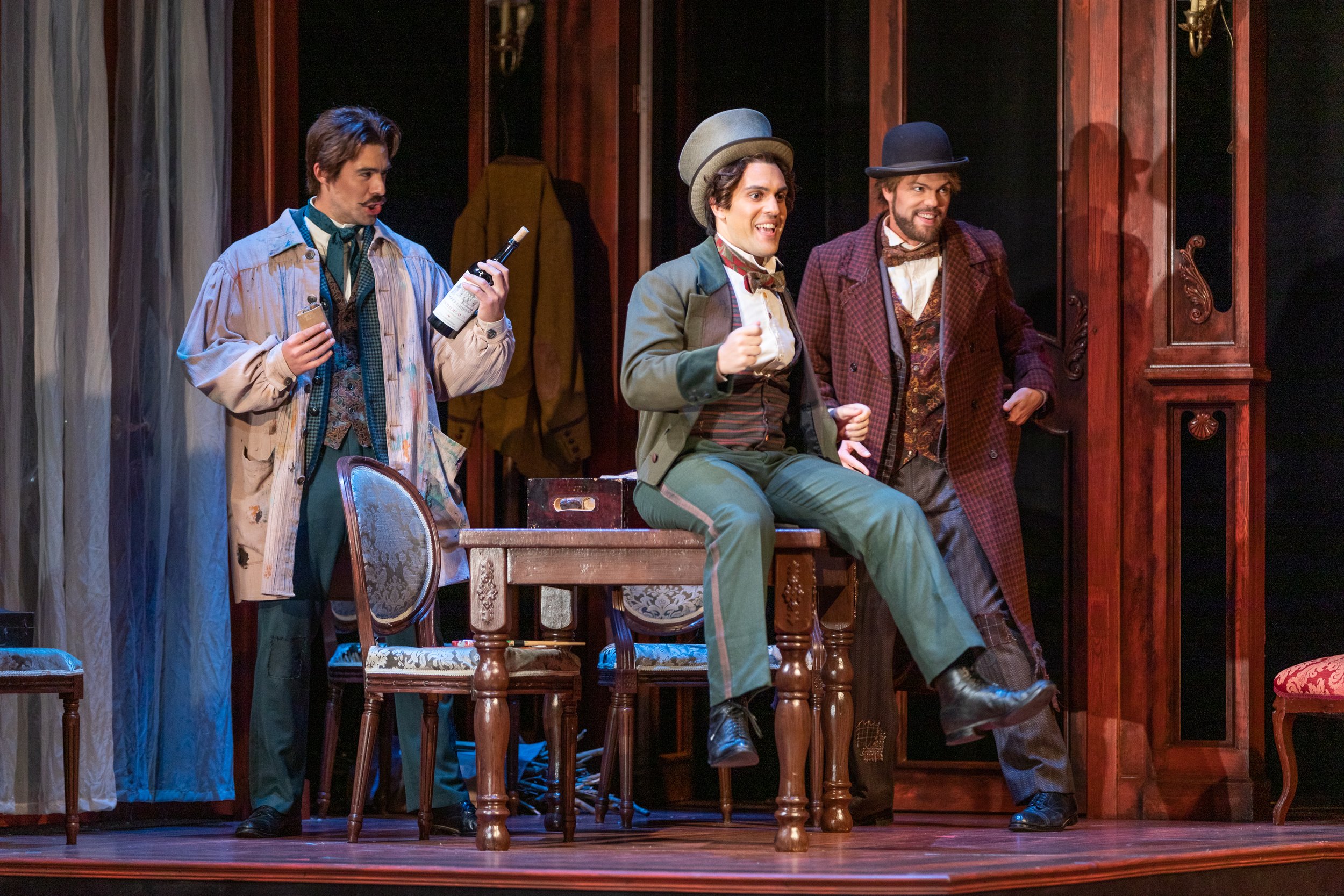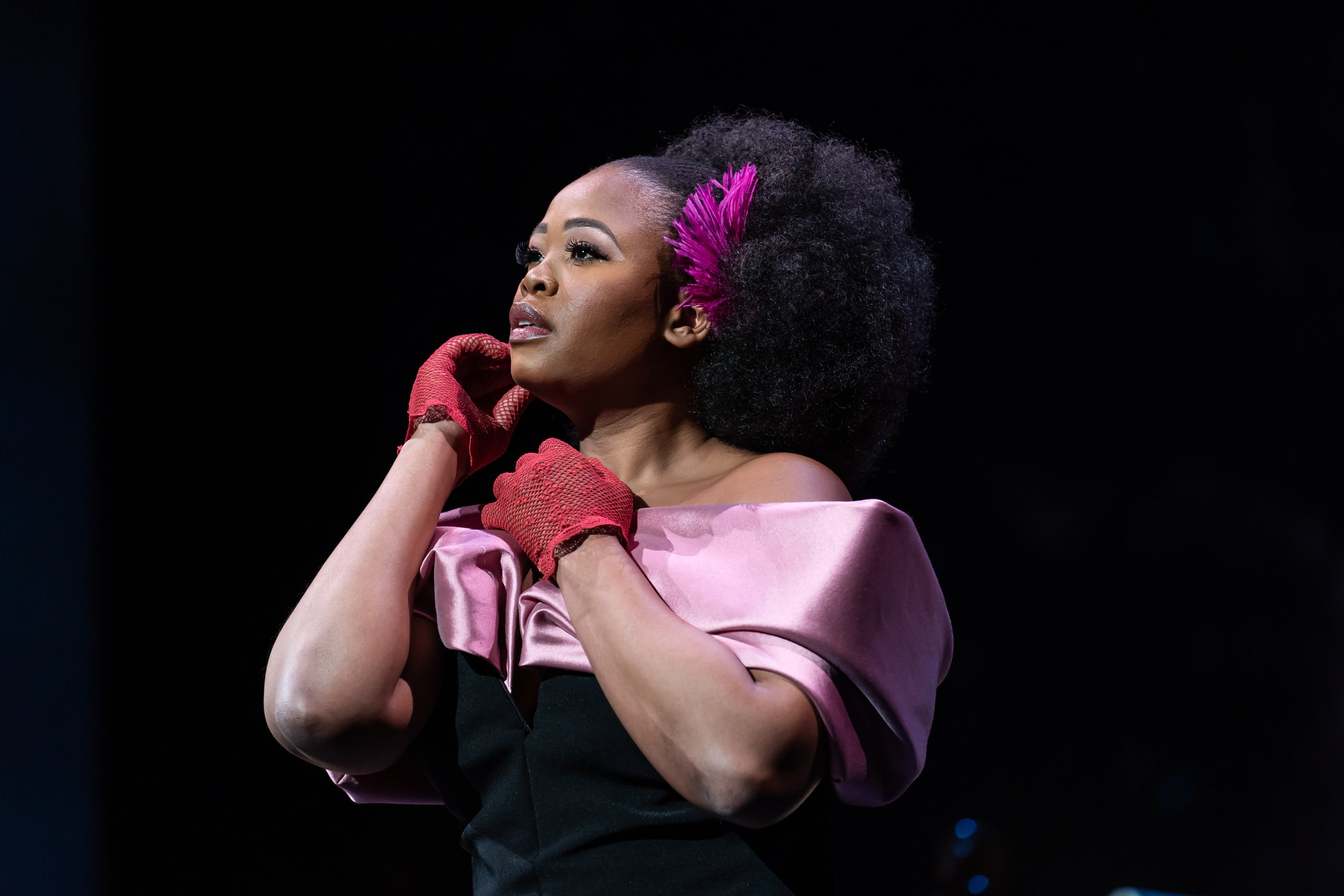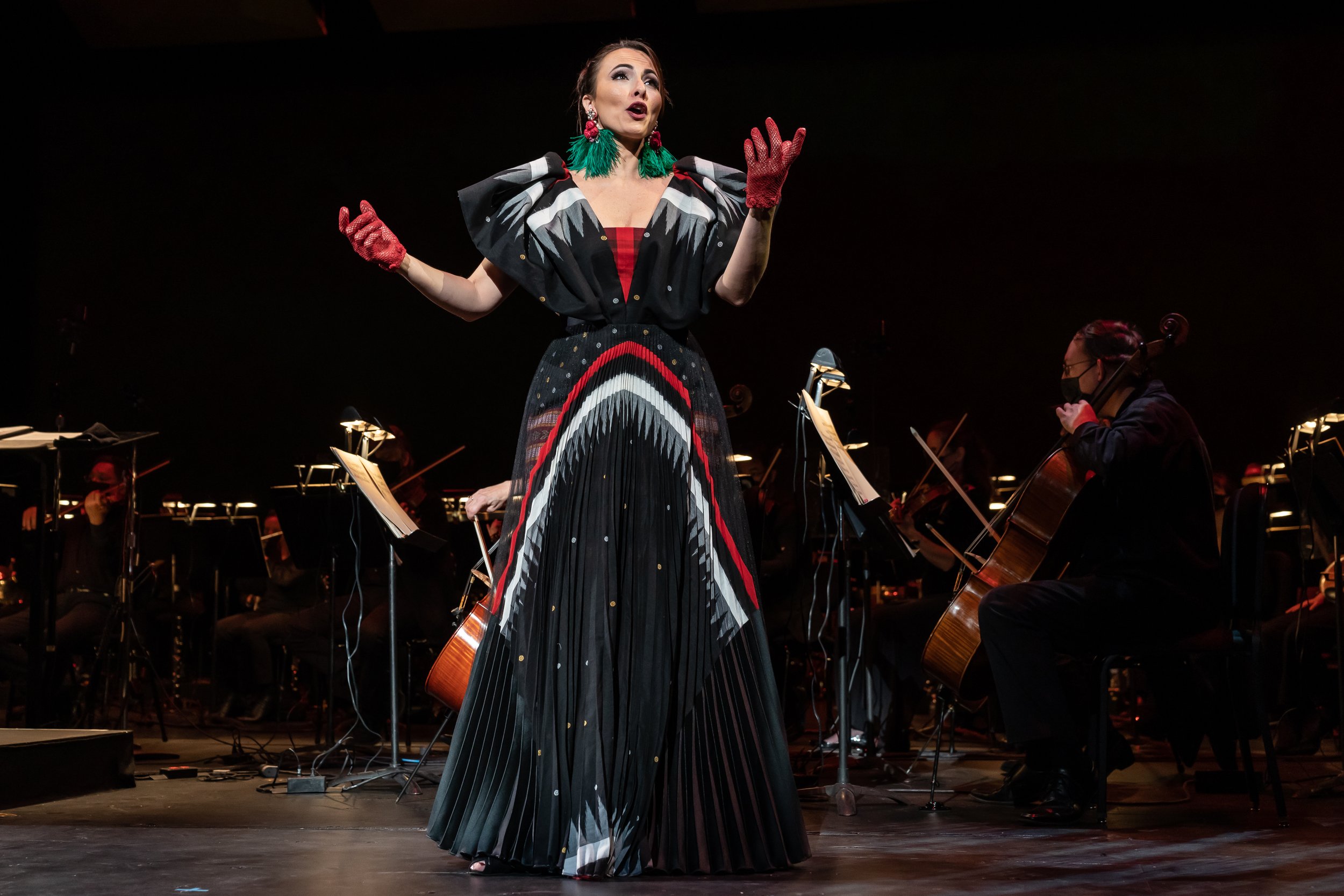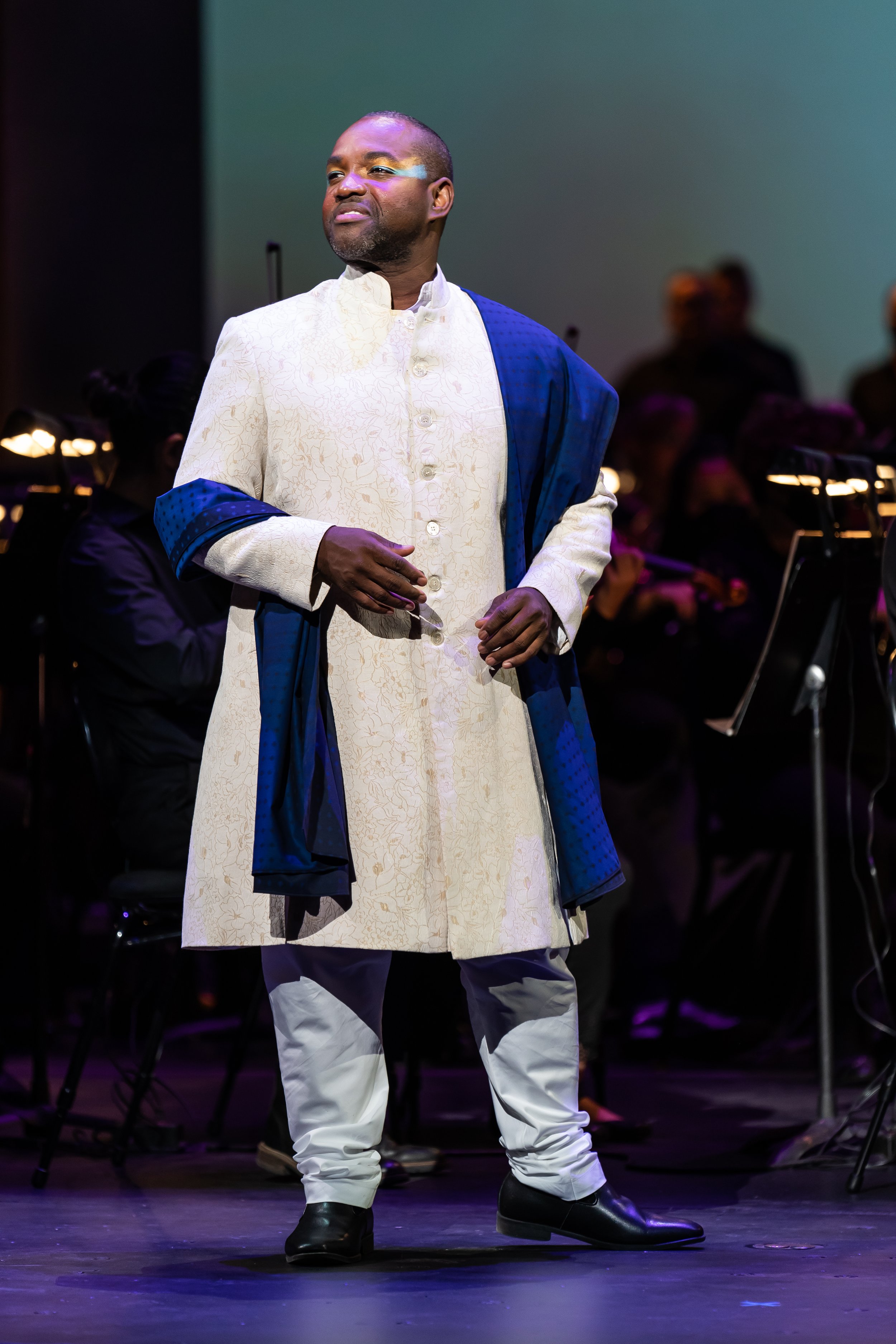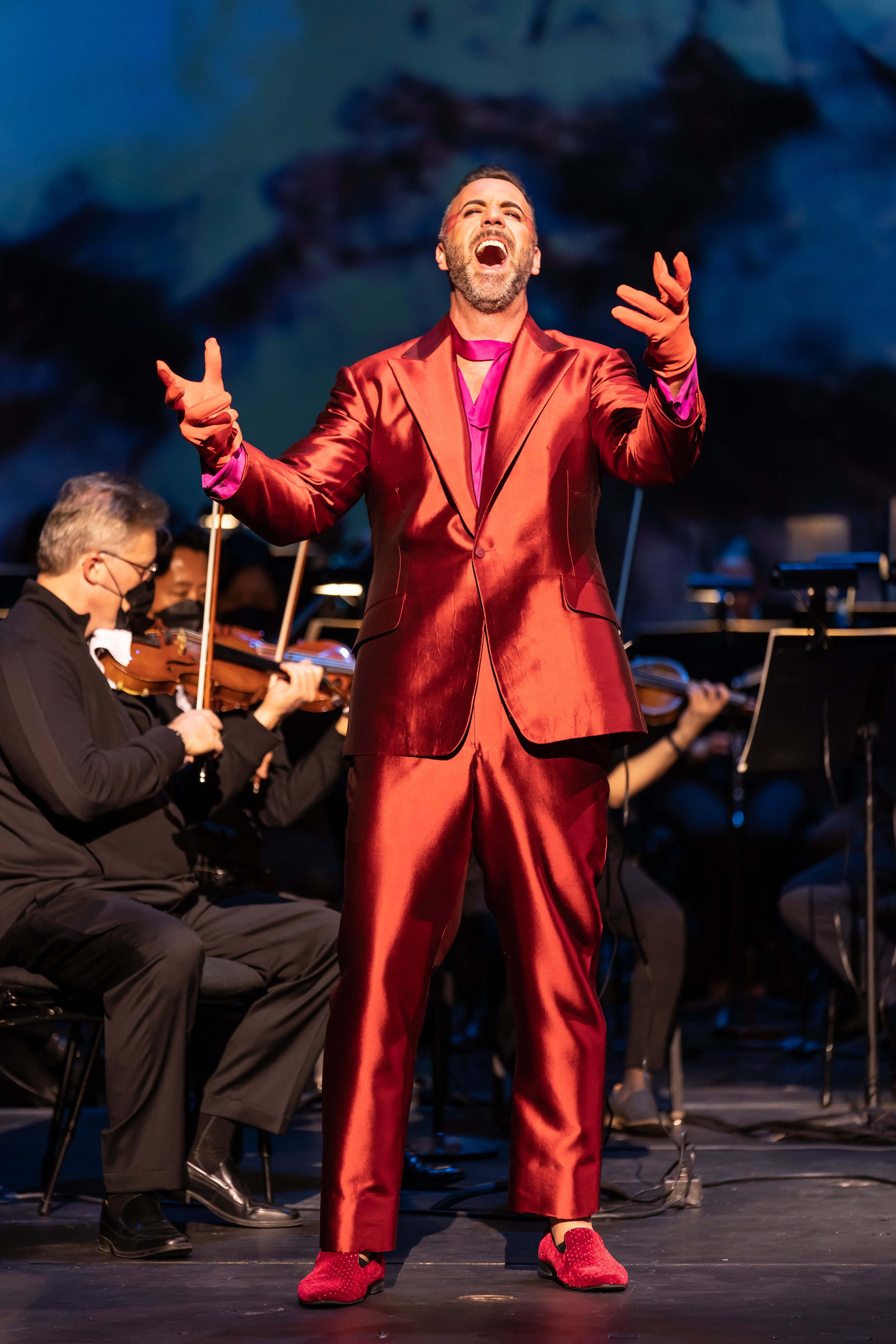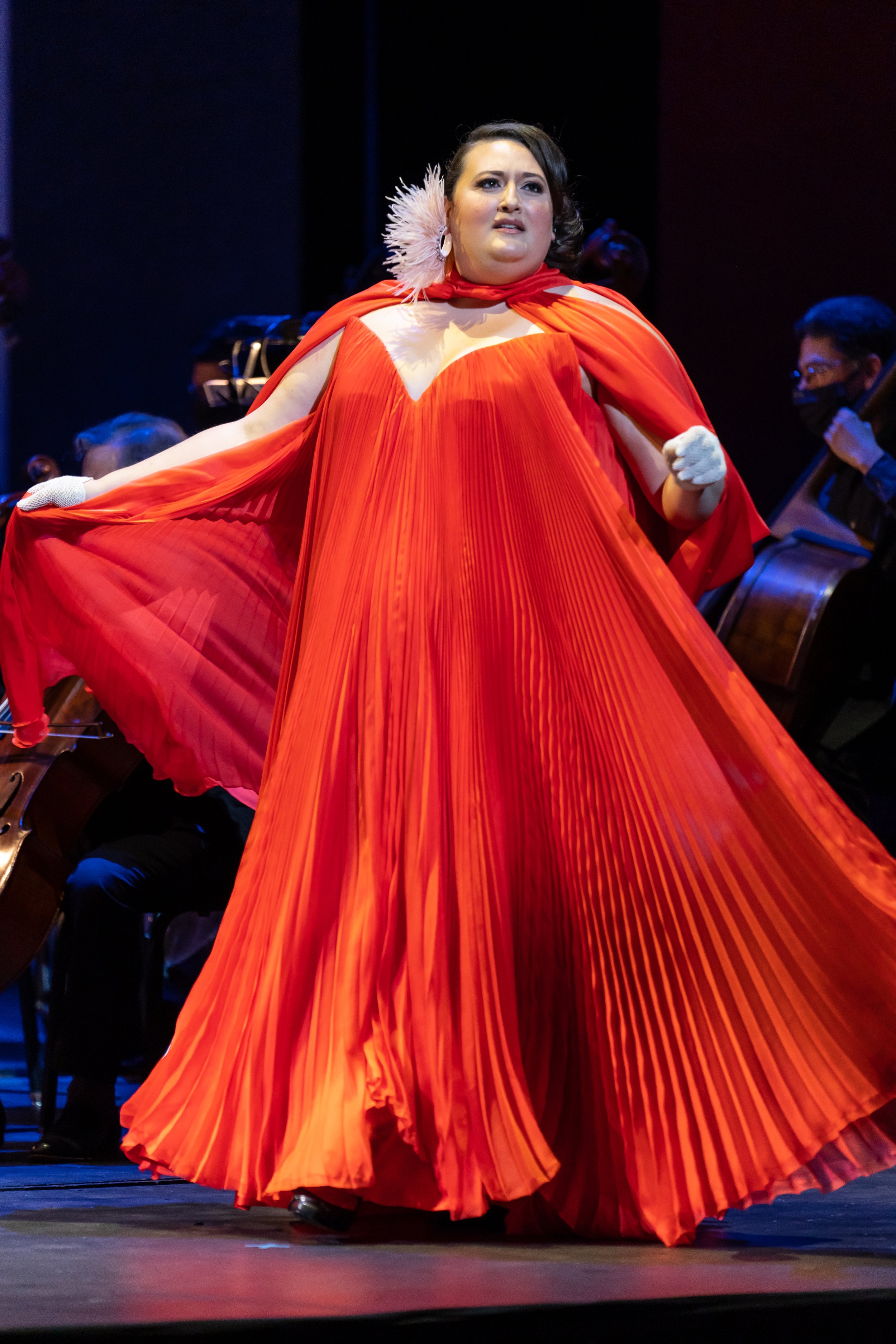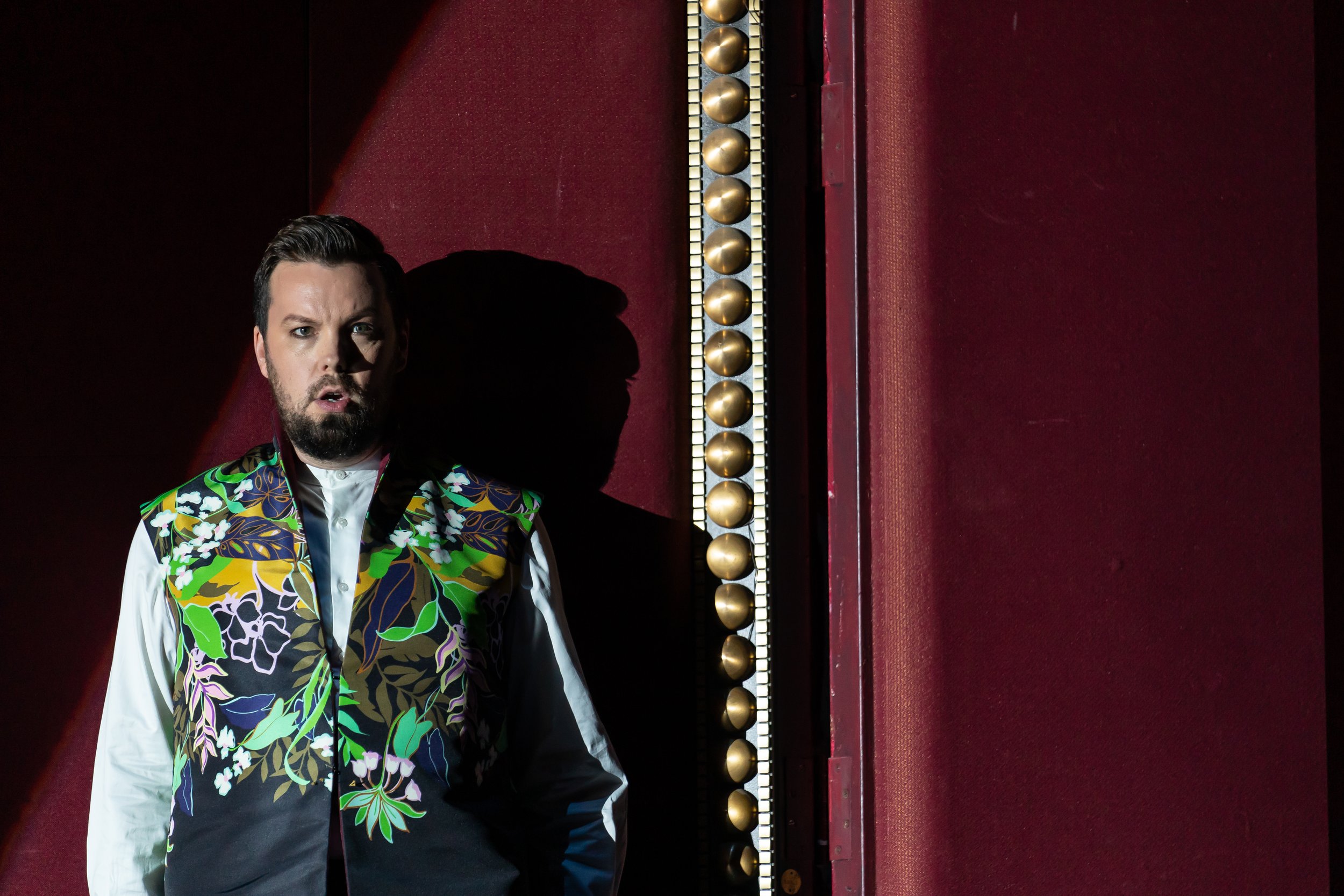Washington National Opera’s Artistic Director Francesca Zambello gives a good show. Count on it. For WNO’s first return to the Kennedy Center’s Opera House after a two-year pandemic-caused hiatus, she selected and chose to self-direct Georges Bizet’s grand opera Carmen (1875), one of the most popular operas of all time. WNO also scheduled its annual GALA to coincide with Carmen’s opening, a GALA that raised over a million dollars for WNO, making the event both a celebration and a performance. It was a happy affair with tuxedos, evening gowns, and sparkling jewels heavily represented in the audience.
Carmen (Isabel Leonard) has many would be suitors. Photo by Scott Suchman; courtesy of Washington National Opera.
Ms. Zambello’s Carmen is a crowd pleasing, classical production which she squarely points towards supporting feminism today. In her program notes, she says about Carmen, “For every choice she makes, she is aware of the consequences, and she is fully prepared to face them on her own. ‘I was born free, and I will die free,’ she says many times – and that’s exactly what she does. I think she is the ultimate feminist.” My bottom line in this report is “Roger that!”.
Composer Bizet died from heart disease in 1875, at the age of 36, before Carmen finished its initial run. It is said that disappointment over the unfavorable reception of Carmen in Paris contributed to his physical decline; he never knew of the success he had created. Of less than ten full operas by Bizet, only The Pearl Fishers also remains in today’s repertoire. One of the first things I remember my son saying to me about opera was that Carmen had too many hit tunes to be an opera. I sometimes wonder if Bizet had lived longer whether his work would have moved into musicals. Given that Carmen contains some spoken dialog, it probably technically qualifies as a musical, though the vocals are fully operatic. He did have an extraordinary gift for great tunes. Anyone who has watched television or is a fan of the movies has heard at least excerpts of music from Carmen. Perhaps not, but one suspects that most people in the western world have hummed the Habanera or Sequidilla or Toreador arias at one time or another.
Carmen (Isabel Leonard) has seduced Don José (Michael Fabiano). Photo by Scott Suchman; courtesy of Washington National Opera.
Spoiler alert for the remainder of this report - In large measure Carmen succeeds via those tunes and Bizet’s great orchestral music, but it has an unusually gripping story, like watching a train wreck you see coming but can’t look away. Many critics who reviewed it in its day spurned it as being immoral. An overtly sexual young woman in Spain lives life freely as a Romani, a gypsy group largely rejected by Spanish society and who chose to live outside the law; she considers her personal freedom inviolate. She seduces a corporal in the military, Don José, and gets him into trouble. Pure-hearted Micaëla, his childhood sweetheart, fails to convince him to come home and marry her. After he is released from a short stay in prison, Carmen persuades him to desert his unit and join her in a group of gypsy smugglers. She then begins to resent his attempts to control her, and she falls in love with a dashing bullfighter, Escamillio. She tries to break away, but Don José pursues her, desperately trying to convince her to come back to him. She throws the ring he gave her at his feet, confirms her love for Escamillio, and challenges him to kill her or let her go. Finally convinced she no longer loves him and will not return to him, in a moment of rage, he stabs her to death. Bizet had to compose music for all of this, the sexy playful and the murderous, including adding a Spanish gypsy flair.
Micaëla (Vanessa Vasquez) tries to persuade Don José (Michael Fabiano) to return to his home. Photo by Scott Suchman; courtesy of Washington National Opera.
On what was the opera based – was there a real Carmen? Probably, but the opera is fiction based on Prosper Mérimée’s novella “Carmen”, published in 1845, that relates stories Mérimée heard about Roma people while traveling in Spain; one story was of a beautiful young woman who seduces and then rejects a soldier who kills her. Bizet proposed this controversial choice to experienced librettists Henri Meilhac and Ludovic Halévy for a new opera he was commissioned to compose for Opéra-Comique, a major step up for Bizet.
The cast for WNO’s Carmen is comprised of international opera stars for three of the main roles: mezzo-soprano Isabel Leonard as Carmen, tenor Michael Fabiano as corporal Don José, and bass-baritone Ryan Speedo Green as Escamillo, the bullfighter. In Friday night’s performance, Ms. Leonard sang beautifully as she always does, and her acting was detailed as it always is. Her Habanera was fun and nuanced but was more professional and measured than fiery. One always expects an edgy spitfire from Carmen; she is often characterized as hedonistic, impetuous, hot-tempered and cold-hearted. This performance gave us a more controlled and calculating Carmen, very self-aware, not so much filled with pent-up anger. Was this the result of Ms. Leonard’s portrayal or Ms. Zambello emphasizing the feminist side? The beauty of Ms. Leonard’s voice and her sexual allure came through clearly in her delightful Sequidilla (Près des remparts de Séville) and subsequent arias. Mr. Fabiano’s beautiful tenor voice and impassioned singing were on display, but he seemed a lost soul from the beginning, not that difficult a conquest for Carmen; I had trouble seeing why Carmen was attracted to him out of all her choices – she could have had an officer. Their final scene together was intense, and their duets were well done throughout. Mr. Green’s performance on the other hand was spirited and entirely compelling from the moment he arrived on stage, very believable as a bullfighter; he brought down the house with his excellent Toreador aria. On stage, he readily became the focus of attention.
Escamillo (Ryan Speedo Green) enters on Honey, the white horse. Photo by Scott Suchman; courtesy of Washington National Opera.
The fourth main role, that of Micaëla was played by the rising star soprano Vanessa Vasquez who sang beautifully and was also convincing as the sweet-hearted girlfriend Don José gave up for Carmen; Bizet gave some of the most beautiful arias to Micaëla. All four main performers have worked with WNO previously, though it was a first in an opera role for Mr. Green. Ms. Vasquez was Donna Anna in WNO’s 2020 Don Giovanni, one of the last, if not the last performance in the Opera House before the pandemic shut down. I recall saying at the time that she was the best Donna Anna I had seen; she also made an outstanding Micaëla. Among the talented supporting players were several Cafritz Young Artists who performed admirably. I especially enjoyed soprano Susannah Waddington and mezzo-soprano Hannah Shea as Carmen’s friends Frasquita and Mercédès. Ms. Waddington has been a standout in the program, and Ms. Shea recently won the annual Annapolis Opera Vocal Competition. Jonathan Bryan as officer Moralès, Kevin Short as lieutenant Zuniga, Kyle Miller as Le Dancaïre, Duke Kim as Le Remendado, and Karma Camp as Lillas Pastia all deserve mention for adding to the success of the performance.
Escamillo (Ryan Speedo Green) entertains with crowd with Toreador. Photo by Scott Suchman; courtesy of Washington National Opera.
The formidable WNO Orchestra under the direction of Conductor Evan Rogister played Bizet’s marvelous music in fine accompanying fashion. The choruses, men’s, women’s, and children’s all gave pleasing performances, bringing Bizet’s excellent choral music to life. Many chorus members, including the children were used to good effect as characters on stage for the drama. Kudos to Chorus Master Steven Gathman.
A fight breaks out between Carmen’s suitors, Don José (Michael Fabiano) and Escamillo (Ryan Speedo Green). Photo by Scott Suchman; courtesy of Washington National Opera.
The staging by Director Zambello had sets mainly composed of a couple of clay colored walls that were moved about on a rotating platform to form a courtyard, a tavern, and a smuggler’s camp for the the different scenes. The period costumes were more posh and added life to the performance. Tanya McCallin served as both Set and Costume Designer. Some aspects seemed a little overdone, such as smoke bellowing forth from the cigarette factory. Except for scenes with only Carmen and Don José, the sets were often filled with performers in lavish costumes; at the end, the performers had to assemble in the back of the stage and come forward in waves for their applause. The staging also featured embellishments, such as having Escamillo ride in on a white horse, guns fired in celebration, and climbers scaling walls. Although Ms. Zambello became Washington National Opera Artistic Director in 2012, her history of directing WNO productions began in 2001. If I have counted correctly, Carmen is her 30th staged opera for WNO. Since I began attending and reporting on WNO operas in 2016, I have seen 10 of 12 that she has directed. So, I know whereof I speak: Ms. Zambello gives a good show.
The cast in an example of the lavish staging of WNO’s Carmen. Photo by Scott Suchman; courtesy of Washington National Opera.
Bizet’s music and the indomitable spirit of Carmen make this opera compelling theater. You will be entertained if you go, though you may not remember this production as the best. You will, however, likely remember for a very long time that that you got to see Isabel Leonard, Michael Fabiano, Ryan Speedo Green, and Vanessa Vasquez have a go at it. I sure will, and the enthusiastic standing ovation at the end assures me that others felt the same.
Carmen ends tragically. Photo by Scott Suchman; courtesy of Washington National Opera.
The Fan Experience: WNO scheduled performances of Carmen for May 14, 15, 16, 20, 22, 25, 27, and 28. Performances on May 15 and 27 have Cafritz Young Artists playing the major roles. Remaining tickets can be accessed at this link; however, the last time I checked, few were remaining. Parking ($25) in the indoor KC parking lot can be reserved online ahead of the day of the performance; there is a discount for KC members. Access through the north side entrances is still closed, but traffic flows freely to entrances on the south side. Taking the Metro to Foggy Bottom and catching the red Kennedy Center buses is a good mass transit option. Before you go, check KC’s masking and vaccination requirements, which often pop up anytime you visit the KC website at kennedy-center.org, but if it doesn’t, click on the banner at the top of the page.
I feel compelled to add this note: if you are an endangered spouse or girlfriend, seek help. My mother was a victim of domestic violence when I was a child. Domestic violence remains a serious problem in the U.S. today.









